

Are Catamarans Hard To Sail? Sailors Experiences!
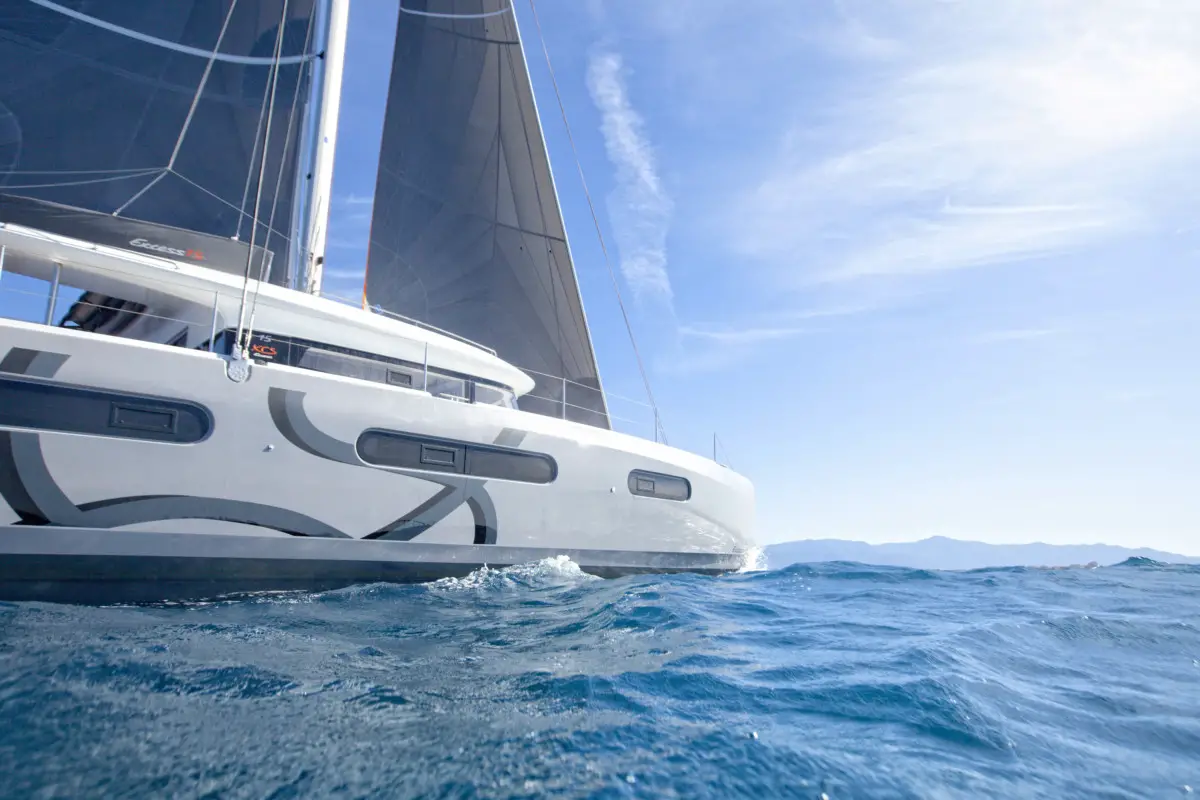
As an Amazon Associate, we earn from qualifying purchases. We may also earn commissions if you purchase products from other retailers after clicking on a link from our site.
People interested in sailing under the most comfortable and relaxing conditions will most likely opt for a catamaran . And with good reason. A catamaran is arguably the most popular vessel choice for safe, spacious, and longer cruising trips.
Catamarans are not hard to sail compared to monohulls due to their superior stability, ease of handling, maneuverability, and visibility from the helm. They can outrun bad weather and deliver a first-rate sailing performance. The most notable downside is catamarans have difficulty sailing close to the wind.
In this article, I summarize what the sailors that I have spoken to say about the ease of catamaran sailing, how they compare to sailing monohulls, and why you should consider a catamaran. The discussion also includes the downsides of sailing these luxurious cruising vessels and tips on how to get the best sailing experience.
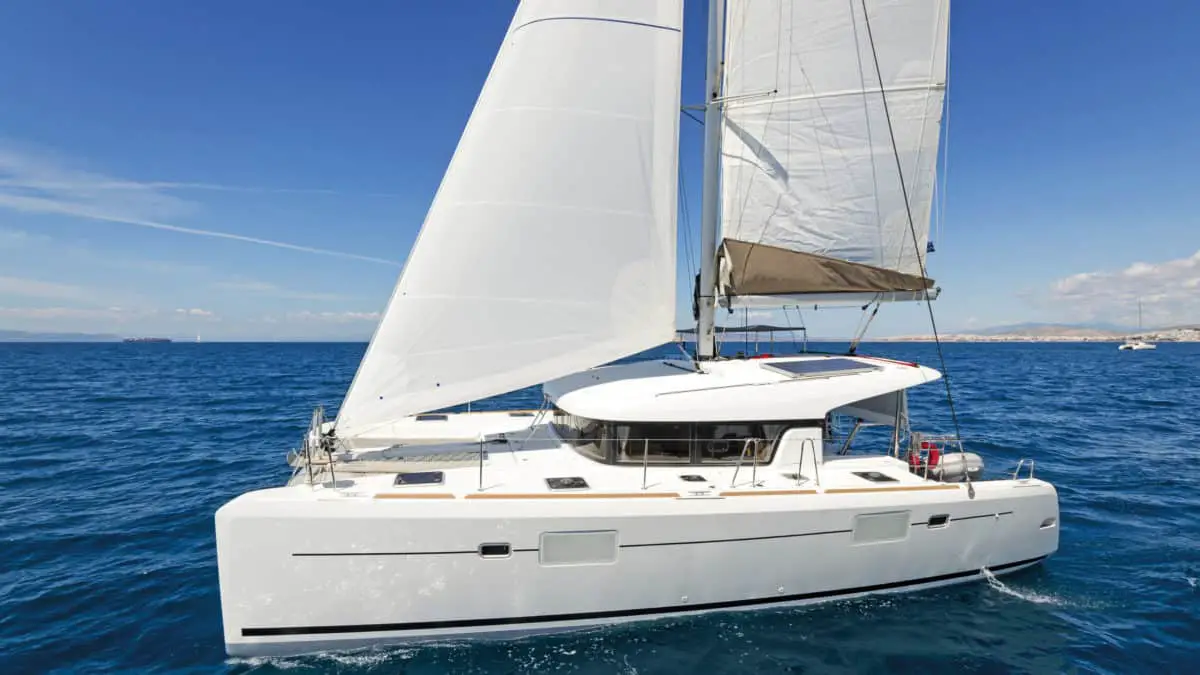
What Makes Catamarans Easy To Sail?
Catamarans are highly stable.
Catamarans comprise two hulls which makes them extremely stable. Their inherent stability allows them to deliver a smooth and comfortable sailing experience since they don’t heel but instead maintain a level stance. This means you’ll be able to move around the boat easier while sailing because you won’t have as much tilt to create a fight against gravity!
The boat’s stability also helps minimize motion sickness and the risk of falling, which makes sailing much more comfortable and safe. Especially if sailing with families, including younger kids and seniors, this will make the experience all that more enjoyable.
When do catamarans capsize?
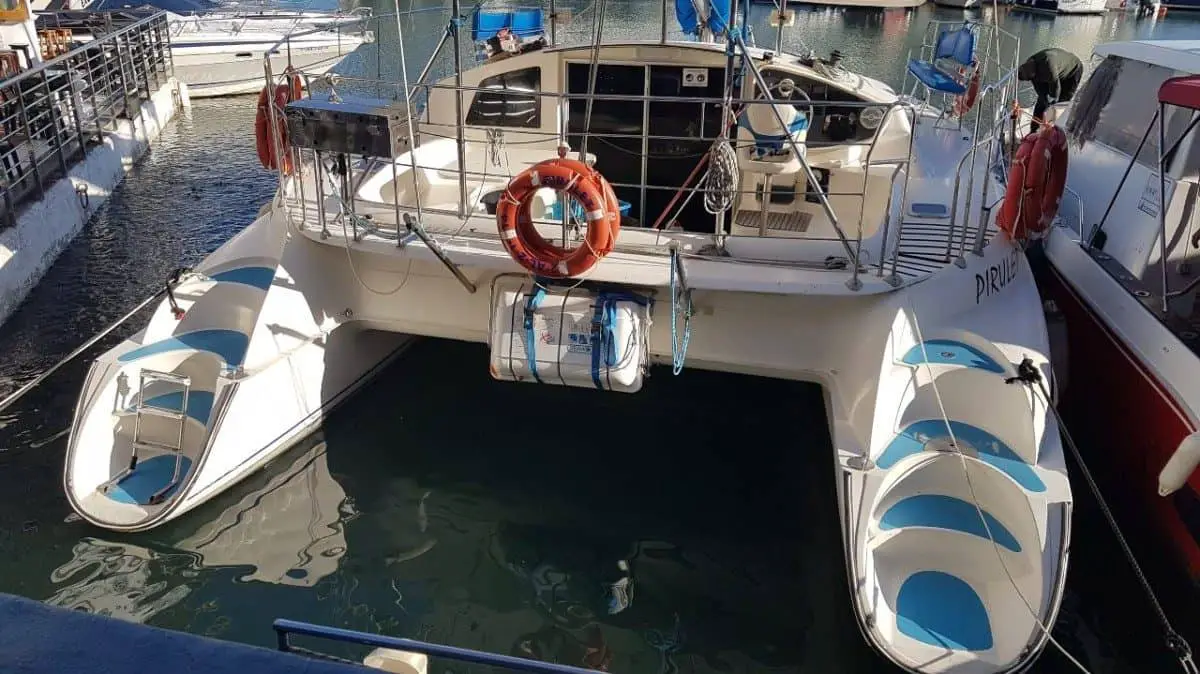
Catamarans Have Double Engines
A catamaran contains an engine on each hull. Because of the twin engines – and twin rudders- catamarans are usually easy to maneuver into bays and harbors. While at the bay, they remain stable even as keel sailboats rock back and forth due to wave action.
The engines and rudders are also far apart, making maneuvering in narrow spaces like inside a marina much easier. Moreover, the location of the engine and sail drive in a catamaran affects pitching when the vessel is underway. Hence for better weight distribution, a central location is desirable.
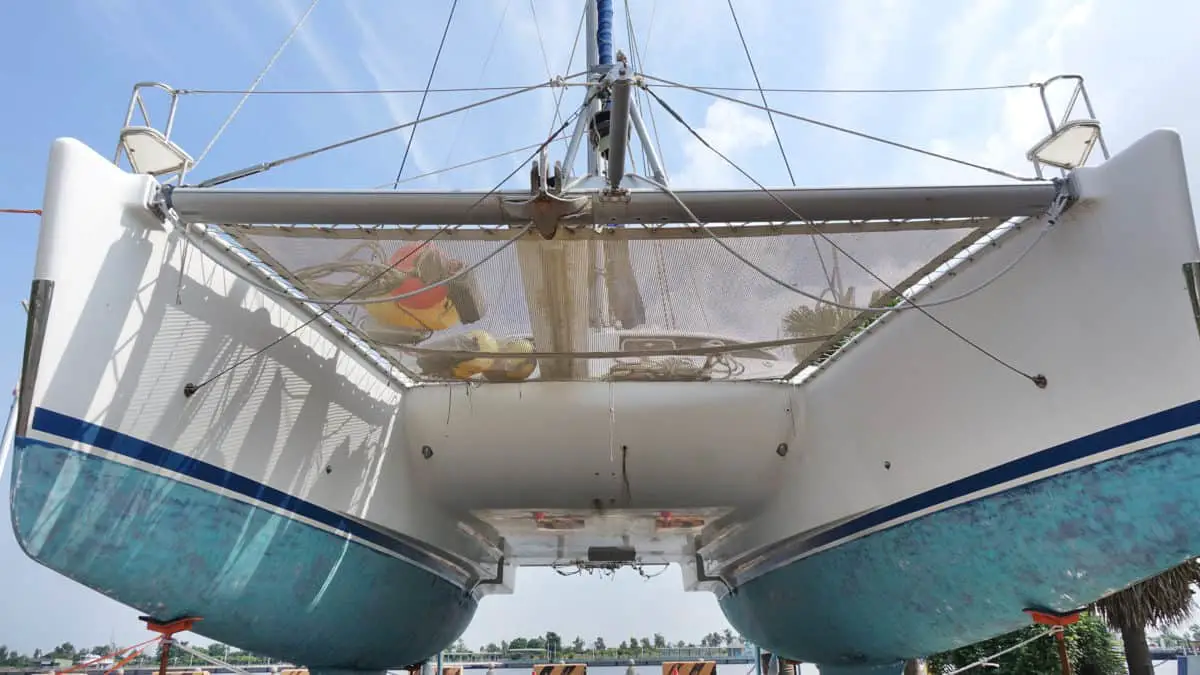
Catamarans Are Almost Unsinkable
Modern cruising cats are safe, sea-worthy vessels designed to safeguard against capsizing. To this end, they have a low center of gravity, while their power-to-weight ratio helps to ensure that the hull remains stable and secure in any conditions.
Production catamarans also boast incredible amounts of in-built buoyancy and roll inertia, making it quite difficult for them to sink. Furthermore, since the two hulls are independent, a catamaran will simply float if one hull gets a leak or suffers damage. However, if a large catamaran gets overwhelmed and capsizes, it’s usually not able to right itself up again as a monohull does.
Catamarans Have Shallow Drafts
A catamaran’s shallow draft means that the boat doesn’t need to have a lot of water beneath it. This enables you to anchor in shallow waters. As such, you can pull anchor much closer to the beach with no fear of rolling during the night. Furthermore, its dual engines and rudders make docking such a simple affair that a bow thruster is unnecessary.
Another exciting feature is the high bridgedeck clearance which helps reduce the noises formed by slapping waves. This is more of an issue when sailing upwind and could cause concern during rough sea conditions.
Additionally, heavier boats experience heavy slamming while lighter boats ride the wave due to their higher buoyancy, thus reducing the slamming effect. In general, 30 inches (76.2 cm) of clearance is suitable for most catamarans.
Want to know how to park your cat on the beach?
Catamarans Allow for Excellent Visibility
Most modern catamarans come with a raised or flybridge helm. The flybridge houses the steering wheel plus all the necessary navigation instruments. It also provides exceptional visibility from the helm position, thanks to the abundant lighting and panoramic views.
Catamarans Have Ample Storage Space
The space between the two hulls makes a catamaran quite roomy and also creates additional living space. As such, the galley, main salon, and cockpit areas are quite spacious. The control panel is within easy access, and it’s easy to communicate with the crew in the deckhouse, on deck, and the saloon.
The extra space also means that there’s ample storage space to ensure that everything is kept well organized and out of the way. The wide, clear gangways also ensure your safety as you walk around the vessel.
Hence, there’s no reason to stow things haphazardly or use bungee cords to help keep stuff in place. What’s more, even in rough seas, most things remain in place. This enhances crew safety as there’s no fear of being knocked over by falling equipment.
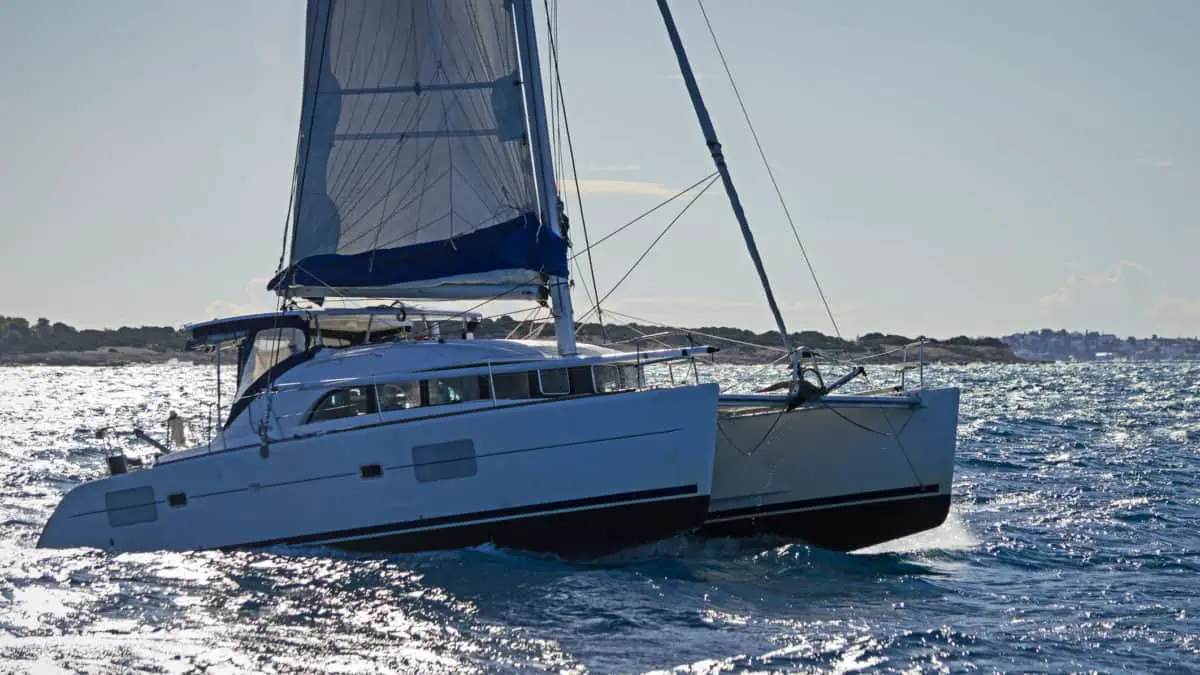
They’re Quite Fast
A catamaran can sail 200 miles a day on passage. What this means is that a catamaran moves fast, enabling you to reach your destination on time. What’s more, you can outrun heavy weather pretty easily or get yourself in a position that allows you to avoid the worst of the storm. In any case, today’s advanced weather forecasting technology will enable you to avoid bad weather conditions.
A cat can move so fast because of its design; there is little of the boat under the waterline. In other words, there’s not much hull space in the water, which allows for much less resistance from the water. The narrow hulls also allow for faster displacement speed.
In addition, because modern catamarans use composite materials in their construction, they’re lighter, faster, and have less drag. The lack of a deep keel also means that they can float much higher on the water, thus contributing to a lower wetted surface and faster speeds.
Catamaran speed explained
Catamaran Systems Allow for Redundancy
Most of the essential navigation systems necessary for onboard safety come in duplicates, which make emergencies in a catamaran much easier to cope with. Engine failure in a catamaran is not catastrophic because the boat sports two engines. You simply maneuver the boat with the remaining engine.
In addition to moving the boat, you can also use this engine to charge your batteries. Likewise, if one rudder malfunctions, you can steer with the second rudder or the engines. The only downside to catamaran redundancy is the high repair and maintenance costs.
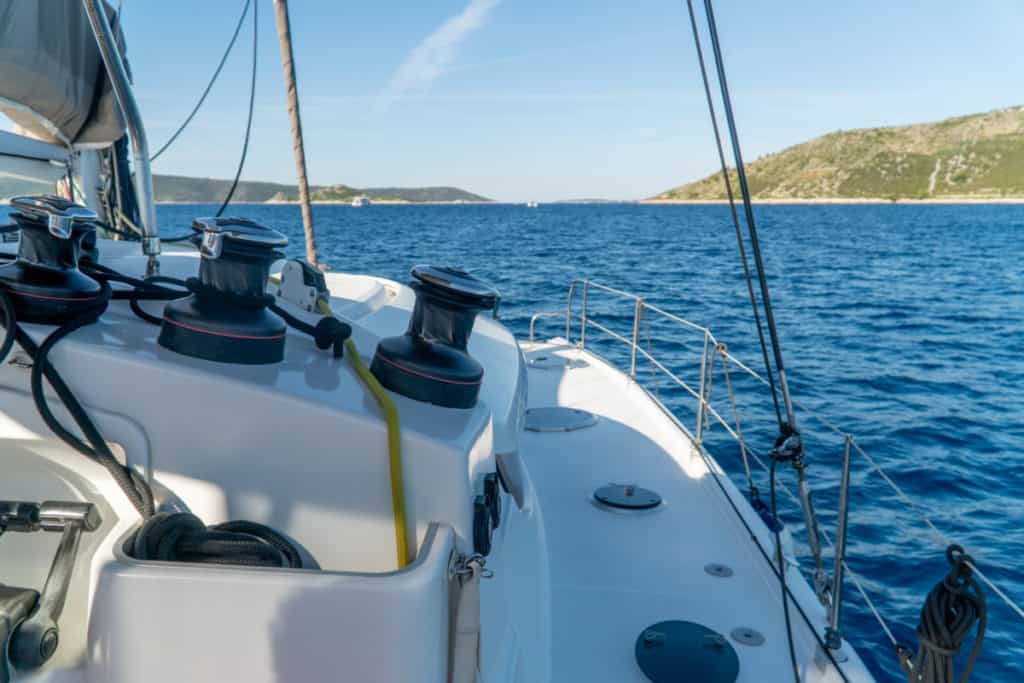
Catamaran Solo Sailing
As the helmsman on a catamaran, you can perform all sailing maneuvers single-handedly. This is because, with most modern catamarans, all the necessary control lines head back to the helm or cockpit. Plus, if you require additional assistance, you can always rely on autopilot.
What is the largest catamaran one person can safely sail?
Having control lines within easy reach is crucial because you may need to act quickly to keep the boat under control when the seas get rough. Sails should also be easy to reef or furl, as you may need to strike sail under hazardous weather conditions, and it’s best if you can do so from the cockpit.
How to setup and solo sail your catamaran!
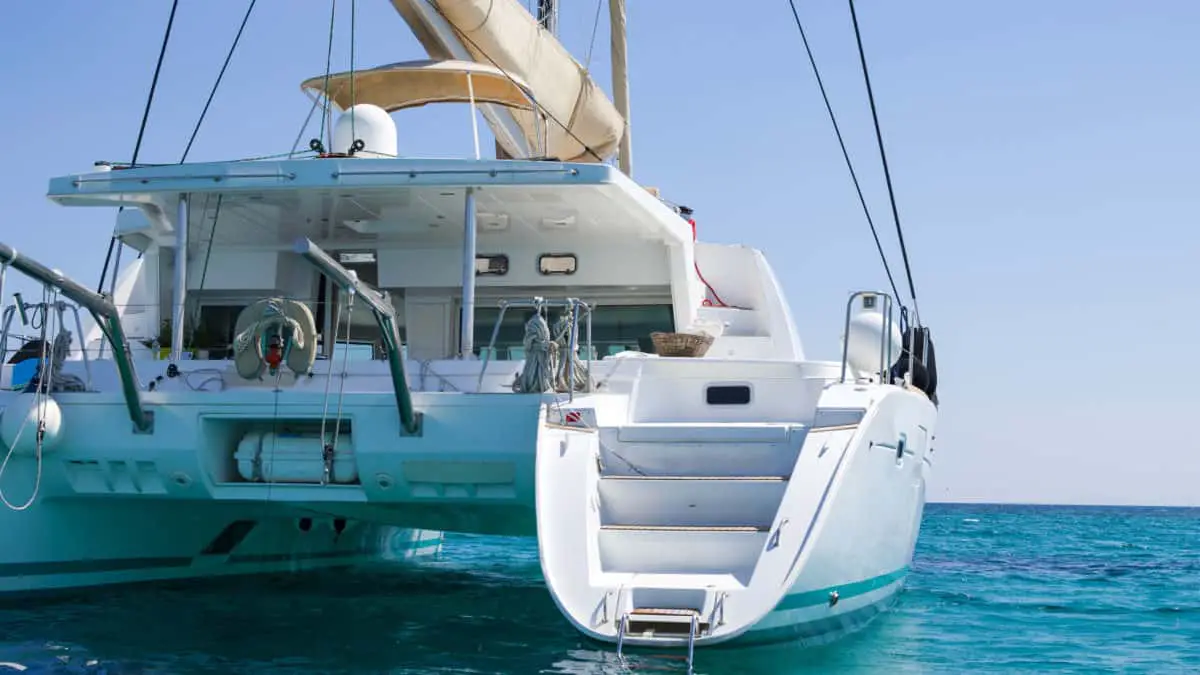
Catamaran Crewed Sailing
A tired and overworked crew is a liability on a sailing vessel. Fortunately, there is hardly any crew fatigue on a catamaran since the crew manages to get a good night’s sleep even when the seas get rough. Besides, sail changes and reefing become more manageable and safer when you’re working on a stable platform as there’s minimal risk of serious injuries or falling overboard.
An alert crew thus contributes to a safer vessel. Still, while a catamaran will not easily flip or capsize, the boat requires a skilled and attentive crew in severe weather.
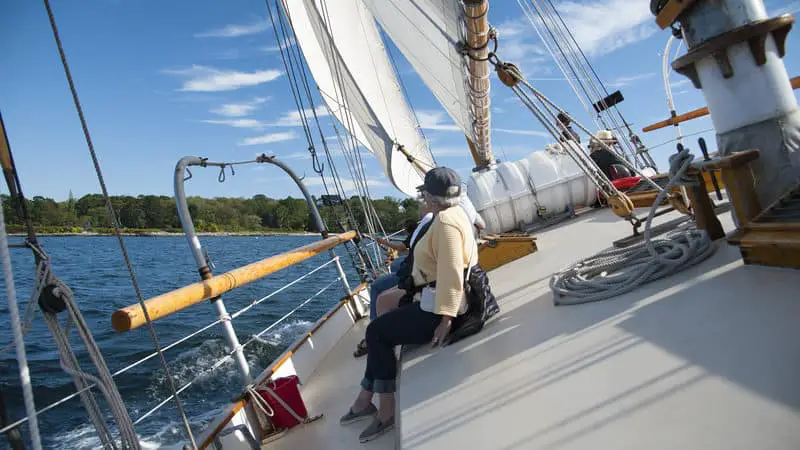
Are Catamarans Harder To Sail Than Monohulls?
Those who have sailed both these vessels consider sailing a catamaran to be easier than sailing monohulls for two major reasons.
- Monohulls don’t have as much space as catamarans ; hence the cockpit is not as spacious or comfortable.
- Monohulls tend to heel, particularly during strong wind conditions. The heel makes it harder to manage sailing tasks such as reefing, winching, or moving the boat about.
But that’s not all. Catamarans have several other notable advantages over monohulls, such as:
- Sailing a catamaran is less tiring.
- They can sail in shallower waters.
- They can make a 360 degrees turn.
- They move faster when sailing downwind and across broad reaches.
- You can rely on one engine in case of engine failure.
- The minimal wetted surface area on catamaran hulls makes them more fuel-efficient.
- They’re easier to maneuver than deep-keeled monohulls, which heel in strong winds making sailing difficult.
- Modern catamarans may not be self-right, but their positive buoyancy prevents them from sinking in the unlikely event they capsize.
Why Should You Choose a Catamaran?
Catamarans are popular in the sailing world because they’re high-quality offshore cruising vessels. Highly innovative and built to the highest quality standards, these luxurious boats are incredibly spacious. This makes them ideal for families or couples keen on making ocean crossings or taking a cruising vacation.
In either case, 42- 48-foot (12.8- 14.6-meter) catamarans make for unique floating homes due to their high load-carrying capacity. Smaller-sized cats might not have sufficient ability to carry the required loads, while larger ones might prove prohibitive in terms of equipment costs.
Other favorable qualities that make catamarans appeal to many people include the following:
- The uncluttered, flat decks make the vessels much safer offshore.
- The separate hulls offer privacy, making it easy to accommodate big families or extra guests.
- Some sailors might be interested in using the catamaran as a motorboat only – without using the sails.
- The seating options available on the bridge deck make it possible to relax as you take in the scenic views.
- The passages are safe, and there’s no climbing involved when moving from the bow to the stern.
Downsides of Sailing Catamarans
Under the right conditions, catamarans deliver a smooth and comfortable sailing experience. However, since they don’t heel, the sailing experience is somewhat different when compared to sailing a monohull. And because the boat’s motion is different, you need to trim your sails differently, too, and pay keener attention to other sailing factors.
Also, it’s more challenging for a catamaran to make headway when sailing upwind or under light wind conditions. Again, since the vessel seems not to react to strong winds, it can be difficult to figure out when to reef so as to avoid getting overwhelmed; hence you need to always keep your eye on wind speed to enable you to reef early. Moving upwind can also be a bit uncomfortable since each hull rides the wave at its own time.
One thing to note here is that charter or cruising catamarans don’t fare well with windward sailing. These boats sport shallow drafts, small rudders, high flybridges, integrated fixed keels, forward masts, shorter bows, and heavier displacements.
On the other hand, high-performance cruising cats sail windward with no hassles. They feature deep rudders, efficient daggerboards, and less displacement. The daggerboards enable the cat to point slightly higher, enhancing speed in a narrow, upwind steering angle. Ultimately, the most effective way to maintain crew safety in any sailing condition is by paying special attention to your sail selection.
Let’s look into more disadvantages of sailing catamarans below.
Catamarans Provide Less Feedback
As mentioned earlier, a catamaran doesn’t provide you with as much feedback from the wheel as a monohull does . So, when you’re sailing during stormy weather, you need to be vigilant. Doing so will help you avoid surfing down waves, burying your bows, or pitch polling.
A large-sized catamaran carries a lot of sail when moving downwind. It also uses a lot of force. Therefore, you have to keep a step ahead of the vessel, anticipate its behavior and adjust accordingly. In this regard, having a skilled and attentive crew goes a long way to ensure that the boat and everyone on board remains safe.
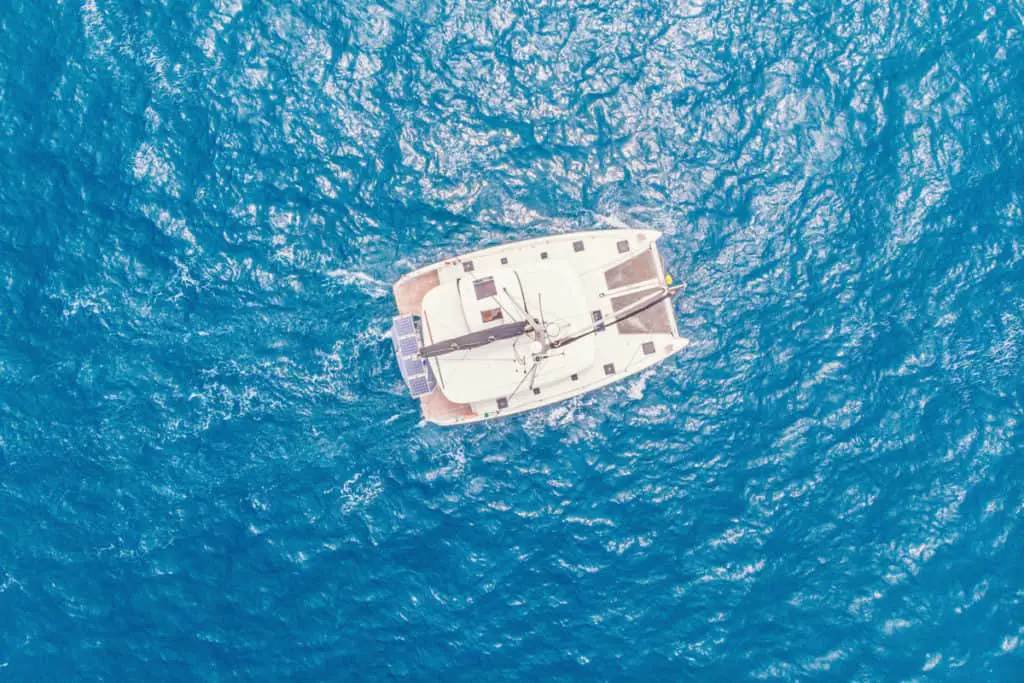
Catamarans Can’t Sail Too Close to the Wind
Monohulls sail pretty close to the wind, a feat that catamarans fail to achieve quite as well, especially when sailing upwind. Nonetheless, catamarans make up for this con with their faster speed. They often arrive at a given destination at the same time or earlier than a similar-sized monohull, even if they had to cover a longer distance.
Catamarans Can Easily Drift Off
Because of the large hull areas and shallow draft, sailing catamarans can drift off quite easily if exposed to strong winds. Their great wind resistance (windage) and less drag owing to lacking a keel make the wind more likely to blow them in an unwanted direction.
As a result, you may want to perform anchoring maneuvers during anchoring as soon as you can if the wind starts blowing from the side.
Watch the video below for more details:
Tacking a Catamaran Is a Little Bit More Difficult
Tacking a catamaran is more taxing than tacking a monohull. A boat requires enough speed to carry it through the tack without reducing its forward momentum. As such, a catamaran that fails to complete a tack successfully could end up pointing upwind ( stuck in irons), lacking in speed, and unable to maneuver.
You may need to switch on the catamaran motor during light winds or heavy traffic to help you get through the tack.
Watch the short video below to learn more about tacking a catamaran:
Locating a Suitable Berth for Catamarans Can Be Challenging
Due to its double hulls, a catamaran occupies double the space taken by a standard-sized monohull. Finding a suitable berth for your catamaran might not be that easy because you will need to get double space in some locations.
Consequently, marina fees could work out pretty steep for your catamaran; hence you may want to consider spending more time at anchor. You can access a lengthier dock near a wide channel or look for a secluded cove.
Tips To Enhance Your Sailing Performance on a Catamaran
While catamarans might not produce the super speeds of high-performance sailing boats, they still deliver a satisfactory performance when you apply simple sail trimming techniques . For instance, when sailing upwind, bearing a few degrees off can help make movement easier. Alternatively, you can opt to run the motor.
To achieve the best results when sailing your catamaran, follow these helpful tips :
- It’s better to use engine power instead of the steering wheel when maneuvering your catamaran in narrow spaces.
- Lowering your speed can reduce the pounding noise occasioned by wave action against the boat while sailing in heavy seas.
- Avoid carrying too much weight as this will slow down the boat.
- Keeping your catamaran clean and tidy helps to maintain maximum hull speed by avoiding issues such as marine growth or propeller damage.
- Make a point to learn your boat’s strengths, capabilities, and weaknesses to avoid pushing it to its limits and causing serious damage.
Final Thoughts
If you’re looking to make an ocean passage or charter a boat to cruise the Mediterranean, a catamaran makes an excellent choice for a sailboat. Their stability, comfort, generous spacing, and safety ensure you always have peace of mind whether you’re sailing alone or with family on board. Plus, catamarans are easily handled, with or without a crew.
So, go ahead, make your travel plans and get ready to enjoy an amazing time aboard this magnificent sailboat!
Owner of CatamaranFreedom.com. A minimalist that has lived in a caravan in Sweden, 35ft Monohull in the Bahamas, and right now in his self-built Van. He just started the next adventure, to circumnavigate the world on a Catamaran!
Leave a Reply Cancel reply
Your email address will not be published. Required fields are marked *
Save my name and email in this browser for the next time I comment.
Recent Posts
Must-Have Boat Gear for Catamaran Sailors!
Sailing is probably the most gear-intensive activity I've ever done; there are so many decisions to be made about what gear to buy now, for tomorrow, and what to definitely never buy. The gear on...
6 Best Trailerable Trimarans For Bluewater and Coastal Sailing
Having a boat costs a lot of money, even when you are not using it, marina fees, etc. And once it is in the water most sailors never go very far from their "home marina" and sailing will be somewhat...
Cruise this spring to save up to 20%*! View Offer
Press enter to search
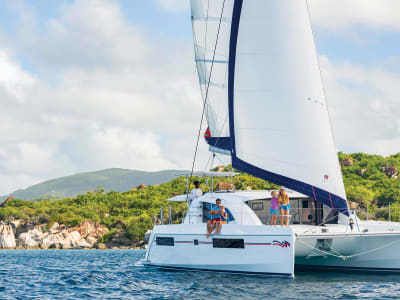
The Beginner’s Guide to Sailing Catamarans
When it comes to sailing, having access to the most innovative, top quality yachts does make a difference. This is how a vacation on the water goes from ordinary to extraordinary. The Moorings catamarans are exclusively designed by renowned boat builders Robertson & Caine , a South African company best known for their Leopard brand of ownership yachts. We are especially proud of the fact that The Moorings was chosen as the only charter company that can offer the award-winning Robertson & Caine catamarans to its clients.
What is a Catamaran?
Are you looking for maximum comfort when sailing and next-level relaxation while on your charter? Then a sailing catamaran is the right choice for you. In contrast to a monohull , the catamaran has two hulls that are connected by crossbeams. Located in the hulls are the staterooms, each with their own private head. The deckhouse and the bridge deck are used as the saloon and galley, and for navigating. Some catamarans even feature another level known as the fly bridge. The Moorings Sailing catamarans provide an idyllic vacation platform for creating unforgettable moments on the water. Additionally:
- Thanks to their two hulls, catamarans offer a lot of individual living space, which makes the time on board a lot more relaxing.
- Catamarans generally do not yaw. They lay like a raft on the water and sailing them is easy without any heeling.
- Catamarans can anchor in almost any bay as their low drafts make it possible to get closer to shore than a monohull.
Advantages of a Catamaran
Sailing – The helmsman is able to execute almost all sailing maneuvers single-handedly as the necessary lines are being redirected to the helm and he can rely on the autopilot for support. Maneuvering , especially inside the marina, is simplified by having two engines and two propellers. Catching a mooring ball is also simpler with a catamaran.
Hulls – The catamaran’s low draft helps in navigating shallow reef passages and enables you to anchor closer to shore. They are also often lighter and have less wave impedance, therefore sometimes making them faster than a monohull, especially when sailing at reaching angles.
Deck – Catamarans have been created with more living space in mind as well as additional areas for enjoying the outdoors. Electric davits make lifting the dinghy easy and the spacious fly bridges offer additional space for lounging and entertaining. As catamarans don’t heel, everyday activities like cooking can be performed at ease.
Differentiating Features
Navigation – An important feature of a charter yacht is safety, which includes easy access to the control panel and the ability to communicate effortlessly with crew in the deckhouse, saloon and on deck. Our catamarans offer a large sail area, making it easy to sail and maneuver even with little wind.
Set-Up – The clients’ needs should determine the design and construction of a sailing catamaran as comfort and quality are pivotal. This includes optimal hull design for more volume in the interior, spacious deckhouses, interior and exterior living spaces that are connected with each other, and seating options on the bridge deck for taking in the beautiful views.
Safety – Duplication of many systems relevant for onboard safety are an additional benefit of catamarans. For example, there are two engines, one in each hull, and two rudders. A catamaran offers flat, even decks, wide, safe passages, and no climbing when having to move from bow to stern.
Tips for Sailing a Catamaran
- With its large area exposed to wind and its low draft, a sailing catamaran can drift off easily so anchoring should be performed as swiftly as possible, especially if the wind blows from the side.
- In order to use the engines rather than the steering wheel when maneuvering it’s best to turn the wheel to twelve o’clock and work exclusively with the throttle control.
- When making a turn it’s best to approach fast, possibly letting the jib luff so that the wind can push the bow around.
- Because of their wide beam, catamarans are usually more expensive when it comes to docking. You can avoid these extra costs by looking for a secluded cove and anchor there while enjoying the tranquil scenery.
Contributor
Leslie Montenegro
See All Leslie’s Articles
You may also like

The Benefits of Chartering a Power Catamaran
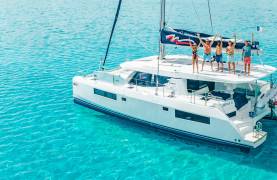
The Moorings Partners with US Sailing

10 most romantic destinations to consider exploring in 2023

Gordon Ramsay, Gino D'Acampo and Fred Sirieix on a luxury yacht in Greece
Step aboard here.
Start your experience with The Moorings on land and sign up to receive e-mails from us about yachts, offers and destinations.
By clicking 'Sign up' you confirm that you have read and understood our Privacy Policy and consent to our use of your information.
Plan Your Dream Vacation
- First time on a catamaran: what you need to know
During your captain training, you'll have learnt how to manoeuvre a monohull sailboat . But what about when you have the opportunity to sail a catamaran? Find out everything you need to know, including differences from monohulls, important factors to consider, pros and cons, and recommended destinations and catamaran models. If you're new to catamaran sailing, this is the perfect guide for you.
5 reasons to rent a catamaran
What are the main reasons why someone decides to sail on a catamaran? Here are the top benefits of choosing this type of boat.
1. Stability
The double hulls of a catamaran provide exceptional initial stability, allowing it to remain afloat and stable in rough waters and wind. If you're looking for a smooth and peaceful sailing experience, especially with small children or seasickness-prone individuals, a catamaran is a great option. It's perfect for taking along your grandma or a nervous friend who's never been on a boat before.
YACHTING.COM TIP: Getting seasick is not only a major worry for novice sailors, but also holidaymakers on a boat trip. But it even can affect experienced sailors from time to time. Those with darker humour say it has two phases — in the first phase you become so sick you're afraid you're dying, and in the second, you're afraid you're not going to. The important thing, though, is to understand why it happens and try to prevent it. Although you'll significantly reduce suffering from seasickness on a catamaran, what works best if it does occur? Find out in our guide — How to cope with seasickness .
A catamaran offers more space than any other boat of similar length. With spacious saloons , plenty of seating and lounging areas , and ample sunbathing spots (such as the netting known as the trampoline ), you'll never feel cramped. The cabins are roomy and the bathrooms are as big as those in many apartments. People who dislike tight spaces or value their privacy will find a catamaran ideal. On larger models (50+ feet), you'll have so much space, you may have trouble finding each other. Despite its comparable length, a catamaran always feels larger than its monohull counterpart. If you're used to a 50-foot sailboat, try a 45-foot catamaran and you'll still feel like you have more space.
3. Amenities comparable to a hotel room
Not only are the cabins spacious, but they are also comfortable and cosy. They usually come equipped with high-quality bedding, pillows, shelves, reading lamps, and more, making them feel like a proper room. That's why we wrote an article highlighting 9 reasons why a sailing holiday is better than staying at a hotel and it's doubly true with a catamaran.
4. Added extras
Catamarans often come equipped with the latest technology and gadgets. These include solar panels, generator, a seawater desalinator, a modern plotter with GPS, and autopilot . These will make you more self-sufficient at sea without needing the facilities of a marina as often.
5. Shallow draft
The reason why catamarans are so popular with sailors, especially in exotic countries , is the very shallow draft — 0.9 to 1.5 metres, depending on the length of the vessel, which means skippers don't have to concern themselves so much about hitting the seabed. While caution and monitoring charts are still necessary, it provides greater freedom in choosing anchorage spots, allowing you to sail almost right up to the beach and anchor to enjoy the peace and tranquillity.
Only small fishing boats can get as close to the shore as catamarans.
Check out articles about other boats and boating gear
Advanced sail trim techniques
The ultimate yacht cleaning kit
The most popular catamarans of 2023
How to sail a yacht on a tailwind
How to sail a yacht in crosswinds
Götheborg: the greatest sailing ship
New boats for rent in 2024
Sail trim 3: become a pro
Sailing through time: a history of sailing ships
Catamaran vs. sailboat: the main differences.
Sailors have differing preferences, with some sticking to single-hulled boats and others preferring catamarans. In fact, which is best has been a hot topic since sailing began. This makes understanding the benefits and drawbacks of each hull design essential so you can make your own choice.
1. Rental price
One major drawback of catamarans is their higher cost on the charter market. Single-hull sailboats can be rented for 1,000-2,500 euros per week, while a well-maintained catamaran typically starts at 3,000 euros per week. However, this may not be the case for all models.
YACHTING.COM TIP: If you want to save money on your catamaran charter, we recommend booking it in advance. Check out our 8 reasons why Early Bird deals are the best way to rent a boat .
2. Capacity
The higher cost of catamaran charters is offset by the extra space, comfort, and capacity — it can often hold up to 12 guests comfortably. This results in a per-person cost comparable to sailboats and cheaper than coastal hotels, making them popular for island cruising and party boats. However, for a safe and responsible party experience, we recommend checking out our guide — How to enjoy a party on a boat: 10 tips to keep your crew and your boat safe .
YACHTING.COM TIP: Never exceed the maximum capacity of the boat. And remember that even small children count as crew members.
A large crew can comfortably sail on a catamaran
3. Port charges and marina fees
Keep in mind that having two hulls means a wider boat, leading to higher docking fees . This increased width can take up more space than two smaller sailboats. However, the cost per person can be offset by the fact that more people can be accommodated.
4. Speed vs. consumption
Catamarans typically feature two high-powered engines , making them faster than similar-sized sailboats. Even without the power of the wind, you can be flying across the waters and with a better fuel efficiency than motor boats.
Catamarans typically have two basic sails: the mainsail and the foresail and operating them follow similar principles as on single-hulled sailboats. Self-tacking jibs can also be used, reducing the work required to trim and manoeuvre the sails.
For those looking to enhance their sailing experience, a gennaker can often be rented with the catamaran, providing added benefits, especially in light wind conditions. Take a look at our 5 reasons to rent a gennaker .
6. Flybridge
This elevated deck is a common feature on catamarans. Here you'll find the helm station and sometimes additional seating or lounging space. It is a valuable addition that provides extra living space on the boat.
The catamaran's second deck provides another spot to sit and enjoy views of the ocean
Who is the catamaran suitable for?
Catamarans are the preferred choice for a group of friends wanting a laid-back holiday on the water but are also popular for corporate team-building events and specialised stays like yoga. As their spacious deck provides a safe play area for children , they are also ideal for multi-family vacations.
YACHTING.COM TIP: If you are sailing with small children, safety is paramount. So, check out our guidelines for safe boating with kids , our article on how to survive on a boat with kids , the Skipper mom logbook: sailing with a baby and always try to stick to the 4 essential tips for smooth sailing with kids . If you don't have kids or don't want to bring them along, why not take your four-legged friend? Catamarans offer ample space for dogs to run around, and following these 7 tips can help make your pet a true sea dog.
On the other hand, we wouldn't suggest a catamaran to sporty sailors to chase the wind in, as the catamarans for charter aren't intended for racing or regattas. Due to their design, they have limited upwind capabilities (sailing boats can sail up to 30° wind angle, while charter catamarans can only handle up to 50° to 60° wind angle), making them unsuitable for competitive sailing.
YACHTING.COM TIP: If you have doubts about your ability to safely operate the boat, consider hiring a skipper. We can arrange a skipper for you who is knowledgeable about the area and can take care of the navigation for you or teach you any sailing skills you may be lacking. Remember when planning that the skipper will occupy one cabin or berth in the saloon.
Specifics of sailing on a catamaran
The principles of sailing a catamaran are similar to those of a monohull sailboat, but there are some differences to keep in mind. These may have already been covered in your captain's training course.
Travelling on the engine
A catamaran has two motors , each of which can be controlled separately using its own throttle control. Want to turn on the spot? That's no problem at all with a catamaran — simply add throttle with one motor and reverse with the other. Once you get the hang of this trick, you'll no longer need a bow thruster, although catamarans are sometimes equipped with one. This makes docking your catamaran a breeze compared to single-hulled sailboats.
Travelling on the sails
Sailing varies mainly in what courses you can sail and how strong the winds are. Most charter catamarans perform best on courses at 50 to 60 degrees to the wind. This is a greater angle compared to sailboats. So be prepared to have to adjust your planned route.
If you sail a sailboat too hard, the boat itself will tell you that you've over-steered by heeling. A catamaran won't do that, so you have to be very attentive to when to reef the sails. Usually, you will put in the first reef at a wind speed of 18 to 20 knots and the second reef at 23 to 25 knots.
Best destinations for catamaran sailing
In addition to the more traditional locations of Croatia , Greece , Italy , Spain and Turkey , we rent catamarans all over the world. In these destinations, you appreciate plenty of space , comfortable access to the water via steps, stability on the waves and amenities such as a barbecue and air conditioning .
However, catamarans are perfectly suited for more exotic destinations . In remote locations, the low draft comes in particularly handy as the seafloor is often poorly charted and the beaches are stunning. The large water and diesel tanks, along with an electricity generator, a desalinator to produce fresh water from seawater, and solar panels are especially useful in exotic locations where the yachting infrastructure is less developed. These features help sailors to be self-sufficient and avoid the need to find a dock every few days.
Popular destinations for catamaran sailing include the beautiful Seychelles , Thailand , French Polynesia and the Caribbean (Grenada, St. Lucia, Martinique, Antigua, St. Martin, Cuba , British Virgin Islands, Bahamas, and Belize).
YACHTING.COM TIP: Don't be apprehensive about sailing to more tropical destinations! Check out our guide to exotic sailing holidays . If you are headed to these warmer climes, you will need to find out when the rainy season or the hurricane season starts.
Views in the Caribbean are picture perfect
The most popular catamarans
Popular charter catamaran brands include Lagoon , Bali , Fountaine Pajot , Nautitech , and Leopard . These are the models that have received positive feedback from our clients for years and that we confidently recommend.
The Lagoon 380 offers a true sailing experience, or the larger Lagoon 46 , where you may end up spending the whole morning lounging in its spacious cabin.
The Bali cat space provides amazing seating up at the helm.
The Fountaine Pajot Elba 45 where you'll enjoy relaxing at the bow on the seating or the trampoline.
The Nautitech 46 with its huge saloon.
The Leopard 45 with its gorgeous bright interior, or the Leopard 50 that's so luxurious, you'll feel like a king.
YACHTING.COM TIP: For the discerning sailor, the Lagoon 620 and Dream 60 large catamarans are also worth mentioning. However, it's important to note that most captain's licenses are not valid for these giants and you'll need to hire a professional skipper.
Special types of catamarans
Catamarans have been around for quite some time, leading shipyards to continuously innovate and create new models with unique features and characteristics. So, what are some of them?
Power catamaran
The popularity of power catamarans has been increasing lately due to the fact that they provide the stability and spaciousness of a catamaran without the need to handle sails.
Do you believe that more is always better? Not satisfied with just two hulls? Then we have a unique chance for you to rent a trimaran , a three-hulled catamaran that offers an unparalleled sailing experience. Trimarans are still rare, so you're sure to attract attention wherever you go.
All catamarans in our offer:
Not sure if you want a catamaran or a sailboat no problem, we'll be happy to assist you in finding the perfect vessel. just let us know..

Denisa Nguyenová
Faq sailing on a catamaran.
What are the main differences between a sailboat and a catamaran?
- Number of hulls = stability
- More space = higher passenger capacity
- Higher charter and port charges
- Speed per engine

The 6 Best Ways to Learn to Sail a Catamaran (Complete Guide)
Posted on May 30, 2022

It’s one thing to kick back, relax and enjoy a catamaran ride with friends, family, or colleagues. However, the feeling you get being at the controls is a whole other level. It can prove intimidating if you’re used to a monohull, but no sweat, you’ve got this!
Many sailors are out there, but what did they do to become one? Does it cost a lot of money? Can people teach themselves? How long does it take to learn how to sail a cat?
There are many ways to learn how to sail a catamaran, from online school to apprenticeship. Books are available, and so are sailing schools. Hands-on is always the best way to learn because everything happens in real-time. If you have a friend, it would be nice to shadow that person.
These steps are guaranteed to have your brain ticking and you sailing efficiently in very little time.
1. Go on a Week-long or Weekend Cruise

You may be baffled as to why I began with this. If all you’ve done is day trips, you have no idea what it’s like to spend days at sea , sleeping, eating, and showering in the open air.
If you’ve already done that and want to go right into catamaran sailing, there’s a whole number of short-term courses available. Individuals who don’t have lots of open water will benefit greatly from these intense training programs since they will be able to fully involve themselves in the situation and learn the skills needed.
2. Watch Videos and Read Books
When you first begin, you would rather not be a total novice. If you’ve never sailed before, it’s a good idea to brush up on your knowledge of boat parts, terminology, and more. Beginner books provide you with thorough and instructive samples and images, and an entry-level instructional text, to assist novices in getting their feet wet.
If you’ve already mastered the basics of sailing, look for a more advanced book. Reading is an excellent method to remain up to date with sailing trends and developments.
When discussing catamarans, it’s vital to know the lingo and the most commonly used terms. The ability to communicate and learn from others is greatly enhanced when one is conversant in the appropriate jargon. Basic knowledge of nautical terms is also required.
3. Sail With a Friend or Group

If you learn best by observing others, there are a variety of strategies you can employ to benefit from what they’ve learned. A friend who is a sailor can help you out.
Aside from the obvious benefits of getting out on the water and immersing yourself in the adventure, sailing is an excellent way to meet new people who share your interests. To increase your chances of learning, don’t be scared to make new acquaintances who share your interests.
4. Cruising Catamaran Courses

Choosing the right institution is essential when you’re spending a lot of money on a course. ASA and the US Sailing Association are the most well-known entities that provide upper-edge training with certified trainers.
Enroll in a class if you’re not sure where to begin. Many cruise schools provide courses for all levels of sailors, from the absolute novice to the seasoned sailor.
To ensure that you learn efficiently, these institutions plan course content including land and on-water training programs. To put theory into practice, you’ll board the ship.
If you don’t have contact with a seasoned sailor, you can count on these courses for guidance. Because an experienced and trained teacher is keeping a close eye on your progress, you’ll feel more comfortable being out on the water and having fun.
If you’re looking for courses online, you can check out their syllabuses and pick the ones that work best with your schedule.
5. Join a Crew
Numerous cat owners will always be on the lookout for new additions to their family of feline companions. You can search for jobs both online and offline. Great resources include websites like FindaCrew and Crewseekers. Talk to people at marina bars and see if you could perhaps join a crew there.
6. Sailing Simulation

Were you under the impression that simulation training was exclusive to the worlds of aviation and automobiles? In such a case, you’d be mistaken. Alf has it as well. Playing games is a good way to acquire a sense of what it’s like to go cat sailing. These activities build an understanding of cat sailing.
These games are playable on a variety of different platforms.
Free catamaran handling games from Nautic Ed, for instance, take place in a Caribbean harbor.
You’ll master the cat’s two engines and maneuver your ship without colliding with any obstacles by playing this game. Even though the exercise is a little difficult at first, you’ll pick it up quickly.
Things You Need to Know When Learning to Sail a Catamaran

Catamaran sailing can be learned in any way that works best for you. While some people prefer to learn by reading, others prefer to watch videos. The most important thing is to get on the water and gain some experience, regardless of your personal preferences.
As a result, it makes no difference whatever route you take. Choose a way of learning that works best for you and don’t be scared to fail.
Become Familiar With The Fundamentals
Even if you’ve never sailed in a catamaran before, you’ll need to know the basics. A catamaran, as well as a monohull, are very different in terms of how they can be sailed. My article titled Monohull VS Catamarans: Which Is Better For You? will help you better understand the differences.
Since it has two hulls, the catamaran differs from other types of sailing boats. Because of this, sailing is an entirely different experience.
The movement of a multi-hull boat is more predictable and steady. As a result, prior experience sailing a monohull isn’t required while learning to cruise on a Cat, but it certainly helps. As a result, you might also be able to pick things up more quickly.
To succeed, you must master the following essential skills:
Instructions for Catamaran Rigging
Rigging a boat is getting it ready to sail. Before you put your catamaran on the market, there are a few typical measures you should follow in sequence.
Make a list of things you need to do before the event. You must know how to connect the sails and adjust the boat for varying conditions to get the most out of it. It is possible to ensure that you have taken into account all the relevant safety and security advice in this manner.
Another important skill is knot tying, which helps you safeguard your lines under a variety of weather circumstances. For any occasion, you need to know the ideal knots.
Catamaran Sailing Tips for Beginners

To become a professional sailor, you need to put in a lot of practice, and the best way to learn is by working with an experienced sailor.
Here’s how to make the most of what you know:
Learn to Sail a Catamaran: How Long Does the Process Take?
It might take anywhere from 14 days to five years to master the art of cruising catamaran sailing . A 2-week program will prepare you for the fundamentals so that you may begin learning on your own, though in a safe way. You’ll be an accomplished sailor in around five years.
The time it takes depends on a variety of things, of course.
Sailing lessons often go for up to two weeks, depending on how much time is spent on the water. As a result, you may learn the fundamentals within just under a month if you put in the time and effort.
Regardless of how often you spend studying the concepts with the support of a teacher, you need to have the self-confidence to go out and do it on your own.
On the other hand, it also hinges on your sailing experience. If you’ve sailed a monohull before, picking up the controls of a multihull might be easier.
Choosing the Right Places to Sail
Choosing where to sail determines how much time you have to learn. When compared to locations with strong tidal currents, serene inland lakes and bays are so much simpler to understand. Starting in a quiet and private location is a good approach to learning the basics and building your confidence. You can then move on to more crowded areas after you feel you have honed your skills.
Think of your educational journey as a quest and an opportunity to discover new interests. It’s a great way to learn quickly and then hone your skills as you progress.
Is a Cruising Catamaran Captain’s License Necessary?
Catamarans can be sailed by anyone with no prior sailing experience. As a result, it will be useful in a wide range of scenarios. For instance, the owner of the cat will be more willing to let you use the catamaran if you present him with proof that you are competent.
You can get a recognized certificate from sailing organizations like the ASA and US Sailing by taking their courses and tests.
Call Us (561) 445-5664
How to Sail a Catamaran: 10 Catamaran Sailing Tips

Published Sept 6, 2021
Have you been wondering about how to sail a catamaran? Well then, you’re in the right place as we will provide you the basic information about catamaran boats as well as their advantages and disadvantages. The information we’re about to tell will help you sail your catamaran as easily as possible. Lucky for you, this article includes 10 tips for sailing catamaran boats that you should know.
What Is A Catamaran?
A catamaran is a multi-hull, meaning it has two connected hulls with two engines, two sails, and two rudders. Catamarans are known for their stability and spaciousness. Additionally, they offer larger areas for the deck, saloon, and galley, so this boat is the best option for people who prioritize their comfort over the cost.
Advantages Of Catamarans
- Spacious – Catamaran is a multi-hull, so the space it offers is double the space on usual monohulls . Massive space means more space for bigger rooms, cockpits, and decks. In addition, this multi-hull can accompany more guests all at once.
- Stability – Since a catamaran is built of two hulls, they are more stable, unlike other boats. As a result, multihulls are less prone to rocking and heeling, suitable for guests or crew members with seasickness. In addition, the stability of catamaran boats makes it more comfortable for people to sleep, read, and wander.
- Easy to maneuver – Catamarans consist of two engines and rudders. They are helpful when it comes to maneuvering and docking the boat. In addition, having two engines makes catamarans reliable when emergencies occur.
- Speed – As mentioned earlier, catamarans don’t have kneels, making them lighter than other boats. This makes them faster when it comes to sailing downwind or broad reaches.
- Design – Catamarans’ designs look attractive to the eyes. These multihulls bring prestigious vibes that most guests look for. They are treated like luxurious vessels because of their fascinating looks.
Disadvantages Of Catamarans
- Expensive – Catamarans tend to be more costly than most monohulls or cabin sailing yachts. This kind of boat is more expensive because it provides many features that require more high-quality building materials.
- Availability – Despite being more expensive than other boats, catamarans seem to be very popular these days. Unfortunately, this multi-hull sells out fast, so they are not always available. If you wish to use catamarans, you should book a reservation for your boat early.
Requiring bigger space to berth – Since they provide more space for guests, it takes up as much space. Therefore, this multi-hull usually takes up double the space to berth than monohulls. . (Related: Trimaran vs. Catamaran: Which is Better? )

10 Catamaran Sailing Tips
Here are some tips on how to sail your catamaran:
1. Always keep the boat sailing downwind
Sailing downwind prevents pounding and slapping sounds that slow down the boat. When the low bridge deck slaps on the undercarriage of the boat, it causes annoying sounds. Making sure that you are sailing downwind as much as possible makes your sailing hassle- and noise-free.
2. Speed up before tacking
You must have enough boat speed to tack smoothly. Tacking refers to a changed direction of a boat to achieve the desired destination. If you don’t speed up, you will most likely not be able to tack.
3. Bring the mainsail close to tack efficiently
You can tack efficiently by keeping the mainsail tight and sailing as close to the wind as possible. You must be able to do that without losing boat speed. Otherwise, you won’t be able to tack.
4. Use the jib to help the bows turn better through the wind
Jibing is the opposite of tacking. It’s a sailing maneuver wherein the boat turns its stern through the wind to turn the bows. You should let the jib get backwinded for a while to fix the position of your bow.
5. Bring as many snubbers as you can
Snubber is short cordage attached to the anchor chain and a strong area on a boat together with a bridle. These are used to stop chains from rattling on the bow roller. Snubbers are helpful to prevent and relieve tension on lines and deck fittings. Since the ocean waves can bring pressure to many lines in your boat, you should set up as many snubbers as possible.
6. Use throttle control for maneuvering in normal conditions
The throttle control manages the speed of a boat which makes it ideal to use for maneuvering. You must do this while keeping the steering wheel center.
7. Use engines only when maneuvering in narrow spaces
For maneuvering in tighter spaces, you should consider using the engines only. Using your engines alone is better than maneuvering with steering wheels.
- Use both engines for backing
When your catboat needs to anchor, your two engines will be helpful to you. You can use both engines for faster backing to anchor.
9. Make sure that your boat has completely stopped when you’re going to anchor
Catboats have a shorter keel than most boats, so they are less resistant to water. Catamarans require more time to slow down than monohulls, so you need to be extra mindful when anchoring your boat.
10. Plan advance for weather conditions
Checking the weather when you’re planning to go boat sailing is a must. Even though the weather reports tell you that it would be a sunny day, you should still prepare for other weather conditions. You should be ready and have every piece of equipment needed if ever the rain decides to fall unexpectedly.
Cruising Catamarans
These are the types of cruising catamarans that can be used for your next sailing trip:
Charter/cruising catamarans
This type of catamaran is built explicitly for the charter market. This has small rudders, heavier displacements and can easily struggle even in ideal water conditions. Charter cats usually sail at 55-60 degrees true wind angles (TWA).
High-performance cruising catamarans
High-performance cruising catamarans offer advanced centerboards, deeper rudders, and less displacement, which is better than a typical catboat. If no problems occur, you can sail this type of cat windward at a 45-50 degree TWA.
Sailing with catamarans has its own advantages and disadvantages. However, we can’t deny the fact that it’s one of the beginner-friendly boats to maneuver. Sailing catamarans should be easier for you now that you’ve learned some tips on how to sail a catamaran.
Experience Yacht Charters With Seafari In Boca Raton Florida
Looking for a great time on the water in Boca Raton Florida? Seafari Yacht Charters is number choice for yacht rentals in Boca Raton . Book our yachts for parties , exciting day trips to the Bahamas, romantic yacht dinner cruises , and much more. Come experience all South Florida has to offer with us.

Fact Checked By Experts
Our team of internal experts has conducted rigorous fact-checking on this content. Explore the editorial standard for our website to dive deeper into our commitment to excellence.

About The Author
Krizzia Paolyn has a bachelors degree in Psychology and a passion for yachting in South Florida. She has a desire to be heard and to encourage others to make their voices heard as well.
Related Posts
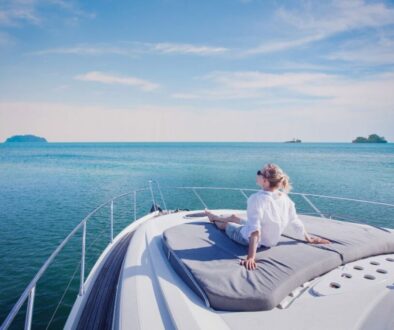
Yachting Benefits You Might Not Know
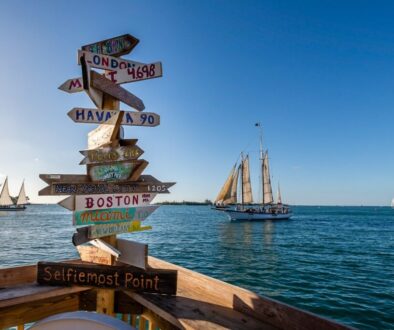
Most Popular , Yachting
How To Charter A Boat From Miami To Key West
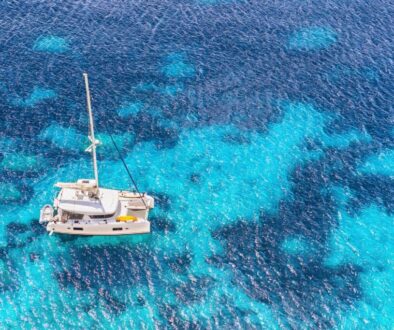
What To Know Before Renting A Catamaran Charter
Find us on social media.

© SeafariYachtCharters.com 2024
View Our Privacy Policy
Website design by Correct Digital
How is Catamaran Sailing Different from Monohull Sailing?
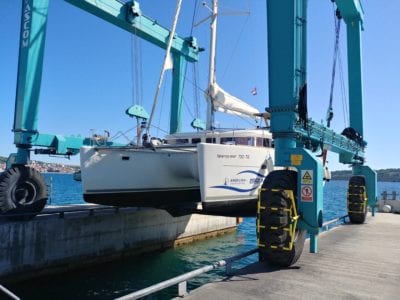
Sailing a catamaran is very similar to sailing a monohull in most aspects. If you learn to sail on a monohull, most of the skills are easily transferable. However, there are a couple of subtle differences that one has to be aware of:
- When tacking, you must work hard to maintain your speed throughout the tack and often need to ease your mainsheet to prevent “windvaning”. Windvaning is when the larger mainsail on a catamaran tries to turn the boat back into the wind.
- When gybing on a monohull, you must be very careful of an accidental gybe, and so you gybe much more slowly. On a catamaran, you can use the increased speed to your advantage and maintain speed while gybing to help depower the main.
- On a monohull, as winds increase, the boat starts heeling which lets you know that you have too much sail up and it’s time to reef. On a catamaran, because they do not heel, you have to be very careful in terms of when to reef the massive main. Typically, you will throw in the first reef at 18-20 knots of wind speed (depending on the size of your vessel) and put in a second reef as the wind gets closer to 23-25 kts)
Most aspects of sailing a catamaran are very similar to a monohull, so making the transition to a sailing catamaran is usually not that challenging of a process!
Why are Catamarans Popular?
Catamarans have exploded in popularity in the last 5 years! There are many advantages to catamarans over monohulls.
- Much more space on a catamaran!
- Catamarans are far more stable than monohulls so they do not heel when sailing, and are less prone to rocking when at anchor. Making for a much more comfortable boat!
- Catamarans have a shallow draft which allows them to enter shallower areas. In the South Pacific, most lagoons are 6-8 feet deep. This is too shallow for monohulls to enter, but a catamaran can easily enter these lagoons.
- Speed: Often, especially downwind, catamarans are faster than monohulls
- More light and airy living area. On a catamaran, the living space is usually up in the middle of the boat, built on the bridge deck whereas in a monohull you go down into the hull where it is darker and feels less open.
- More storage space and room for extra systems like air conditioning, water makers, generators, larger fridges and freezers, etc… Again, having room for all these amenities makes for more comfortable living.
What is a Catamaran?
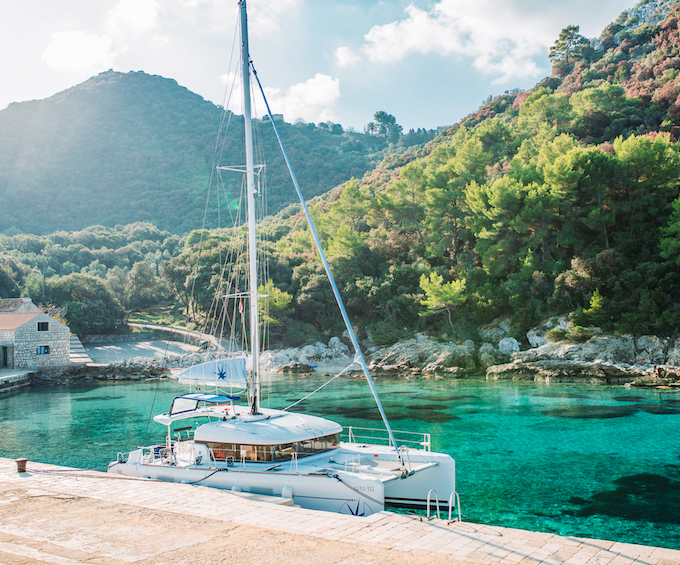
A catamaran is a sailboat with two hulls. These two hulls are connected by a bridge deck. Many people will be familiar with Hobie cats, small catamarans that are popular for sailing on lakes and in calmer waters. Cruising catamarans are based on this same principle but have large hulls that can fit many cabins inside, and house large structures on the bridge deck (like a galley, salon and living area).
Are catamarans safer than monohull sailboats?
Great question! Catamarans are much more stable than monohulls, and so people are less likely to fall overboard, which does make them safer in this aspect. They are larger, more stable boats, and so in most situations, this will make them a “safer” sailboat than a comparably sized monohull.
Catamarans also have the advantage of having 2 engines, which makes them “safer” when it comes to engine problems. On a monohull sailboat , if you have major engine problems you only have the option of sailing. On a catamaran, you always have a second motor ready to help out in an emergency!
Are catamarans easier to sail?
What makes monohulls harder to sail is heeling and more confined spaces. In stronger winds monohulls heel, making most tasks a little more difficult to manage. Whether you are going forward to reef, trying to winch in a sail or moving about the boat, sailing on a heeling boat is more challenging. Catamarans, however, because of their extra stability and room, allow for much easier movement around the boat as they do not heel. For this reason, catamarans are often considered “easier” to sail.
Can a catamaran cross the Atlantic?
Definitely! Early on many catamarans and trimarans were home-built from kits, and many of these boats gave catamarans a bad rap for offshore sailing. For decades now the major catamaran manufacturers have been improving these amazing vessels, and now catamarans are safe, stable and fast on offshore passages. In 2020 we completed an Atlantic crossing in our very own Never Say Never Lagoon 400S2 catamaran.
How fast does a catamaran sail?
Not all catamarans are created equal. Many of the production catamarans like Lagoon, Fountaine Pajot and Leopard are designed for cruising. This means that they are willing to sacrifice some performance in the interest of comfort for their owners and crew. These boats still are often faster than a monohull of comparable size when on a beam reach or downwind point of sail, often seeing speeds in the double digits. Upwind, catamarans do not usually have the same ability to point into the wind (as they have shorter, stubbier keels) and do not travel as quickly.
Some high-performance catamarans from manufacturers like Outremer, Gunboat and HH, make incredibly fast catamarans that can achieve speeds in the high teens and low 20s under ideal conditions.
Want to learn more?
Learning to sail a catamaran has it’s differences from monohulls. If you are planning on sailing catamarans, then it’s best to spend a week onboard one learning how to sail and operate these vessels. We offer catamaran sailing courses in the Grenadines (Caribbean), Sea of Cortez (Mexico), Mallorca (Spain) and Tahiti (South Pacific).
Our week-long live aboard courses truly are an incredible experience! You will spend the week learning over 100 different skills and learn to comfortably sail and operate the vessel. Upon successful completion of the course, you will earn ASA certification 101, 103, 104 and 114 (up to Cruising Catamaran certification) which allows you to charter catamarans internationally.
This intensive course will give you the knowledge, skills and experience to charter catamarans, or help you set sail on your vessel! All while having a blast, snorkelling, hiking and exploring exclusive bays.
- Next Post →
HOW IT WORKS

Connect With Us
Plan Your Trip
START YOUR SAILING JOURNEY NOW
As featured in.

EXCLUSIVE EVENTS
The only way to join our tribe is to learn to sail with Nautilus.
We’re really careful to make sure that we know and trust anyone coming on one of our special trips.
Join us on flotillas, offshore deliveries, free webinars and unforgettable sailing adventures around the world. Join the Tribe.
- TERMS OF USE
- Privacy Policy

Learn the Basics of Small Catamaran Sailing: A Step-by-Step Guide
Alex Morgan
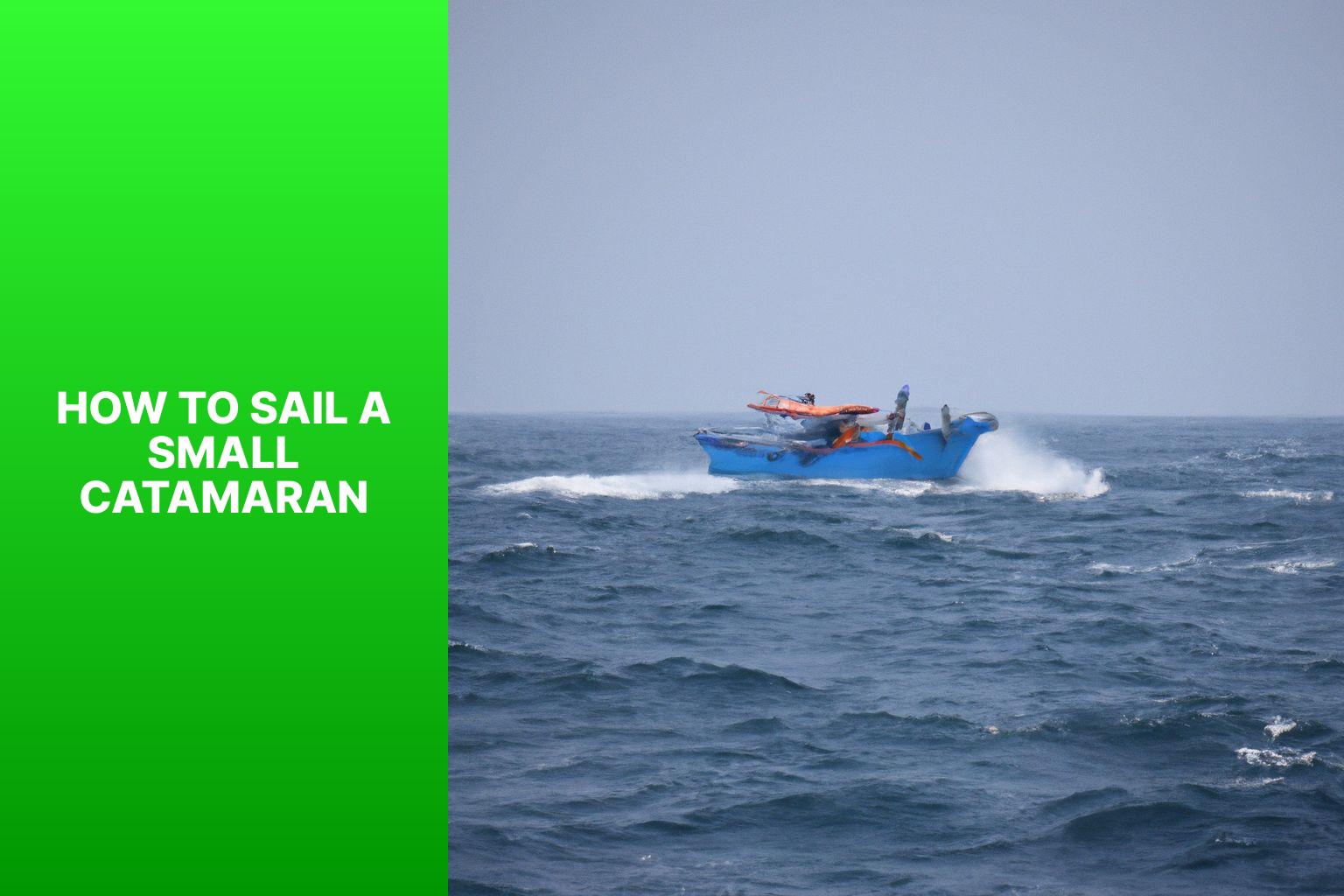
Sailing a small catamaran can be an exhilarating experience, allowing you to harness the power of the wind and glide across the water. Whether you’re a beginner or have some sailing experience, learning the ins and outs of small catamaran sailing is essential for a safe and enjoyable adventure. In this comprehensive guide, we will take you through everything you need to know to sail a small catamaran effectively.
Introduction to Small Catamarans
Small catamarans are multi-hull sailboats that consist of two parallel hulls connected by a frame. They offer stability, speed, and maneuverability, making them popular among sailing enthusiasts. Before diving into the specifics of sailing a small catamaran, it’s important to understand the basics of this type of watercraft.
Getting Started with Small Catamaran Sailing
To begin your small catamaran sailing journey, there are a few key considerations to keep in mind. Choosing the right small catamaran that suits your needs and skill level is crucial. Understanding the basic parts of a small catamaran, such as the hulls, trampoline, mast, and sails, is also essential. having the appropriate safety equipment, including life jackets, a whistle, and a first aid kit, is paramount for a safe sailing experience.
Learning the Fundamentals of Small Catamaran Sailing
Learning the fundamentals of small catamaran sailing will lay the foundation for a successful and enjoyable sailing experience. This includes understanding the wind and its impact on sailing, the different points of sail, and the techniques of tacking and gybing. Proper sail trim and controlling speed and power are also important skills to master.
Basic Maneuvers in Small Catamaran Sailing
Once you have grasped the fundamentals, it’s time to learn some basic maneuvers in small catamaran sailing. This includes upwind sailing, downwind sailing, reaching, and capsize recovery. Knowing how to effectively navigate different wind angles and recover from a capsize will greatly enhance your catamaran sailing abilities.
Advanced Techniques for Small Catamaran Sailing
For those looking to take their small catamaran sailing skills to the next level, there are advanced techniques to explore. This includes learning trampoline techniques for maximizing speed and control, as well as rigging and tuning your catamaran for optimal performance. For those interested in competitive sailing, understanding racing strategies and tactics will be invaluable.
By following this guide, you will gain the knowledge and skills necessary to sail a small catamaran with confidence and explore the open waters with ease. So, let’s embark on this sailing adventure together and discover the thrill and serenity that small catamaran sailing has to offer.
– Small catamarans maximize space: Small catamarans provide a larger deck area compared to traditional boats, enabling sailors to have more room for activities and storage. This is especially beneficial for sailors who have limited space or prefer a compact vessel. – Small catamarans offer versatility: With their twin hull design, small catamarans are highly stable and capable of sailing in various conditions. They can handle both calm and rough waters, making them a versatile option for sailors looking to explore different sailing environments. – Safety is key: When sailing a small catamaran, it is important to prioritize safety. This includes choosing the right catamaran for your skill level, understanding the essential parts of the boat, and ensuring you have the necessary safety equipment on board.
Embarking on the thrilling adventure of small catamaran sailing? This section is your compass to getting started! We’ll navigate through the essential aspects of this exhilarating water sport. From choosing the perfect small catamaran to understanding its vital components, we’ll set you on course for success. Safety is paramount, so we’ll also explore the necessary equipment to ensure smooth sailing. Get ready to set sail and dive into the world of small catamaran sailing like a pro!
Choosing the Right Small Catamaran
To choose the right small catamaran, consider key factors. Here is a table summarizing important aspects to take into account:
Choosing the right small catamaran is crucial for an enjoyable and safe sailing experience. Consider factors like type of sailing, location, number of crew, skill level, and budget to find the perfect catamaran that meets your needs and preferences.
Fact: The fastest recorded speed on a small catamaran was 51.36 knots (about 59 mph), achieved by Paul Larsen of Australia in 2012.
Understanding the Basic Parts of a Small Catamaran
To gain a comprehensive understanding of the basic parts of a small catamaran, it is important to familiarize yourself with the key components that make up this type of watercraft. These components include the following:
1. Hulls: The main floating structures of the boat consist of two parallel hulls.
2. Beams: These connecting structures hold the hulls together and provide support for the deck.
3. Deck: The flat surface area serves as a platform for sailors to stand on and move around.
4. Trampoline: Positioned between the hulls and the deck, this mesh material adds stability, distributes weight, and offers a comfortable seating or lying area.
5. Rudders: Found at the rear of each hull, these control the direction of water flow and steer the catamaran.
6. Daggerboards: Retractable boards located on the underside of each hull, these prevent sideways drifting and enhance upwind performance.
7. Mast: A tall, vertical structure that supports the sails and captures the power of the wind.
8. Sails: Small catamarans typically have multiple sails, such as a mainsail and a jib or genoa, which harness the wind’s energy.
9. Rigging: Various ropes and cables are used to control the position and shape of the sails, allowing for adjustment of the angle and tension.
10. Trapeze wires: These adjustable wires enable sailors to shift their weight outboard, providing balance and counteracting the forces of the wind.
Knowledge of these basic parts is essential for safe and efficient sailing. Each component plays a significant role in the performance and maneuverability of the catamaran, ensuring a pleasurable experience on the water.
Essential Safety Equipment
The essential safety equipment for small catamaran sailing includes:
Life jackets: Each person on board should have a properly fitted life jacket approved by relevant authorities. Ensure accessibility and good condition.
Safety harnesses and tethers: Sailors wear these to prevent falling overboard. Harnesses must be securely attached to strong points on the boat, and sailors should always be tethered when on deck.
Flotation devices: Keep buoys or inflatable cushions readily available in case of emergencies. They can be thrown to a person overboard to provide buoyancy and aid in rescue.
Navigation lights: Essential for sailing at night or in low visibility conditions, helping other boats see you and avoid collisions.
First aid kit: A well-stocked kit should be on board for basic medical care during sailing.
Fire extinguisher: Crucial in case of fires or emergencies. Regularly check and maintain the extinguisher.
True story:
One sunny day, while sailing on a small catamaran, our crew encountered unexpected strong winds and choppy waters. Suddenly, a crew member lost their balance and fell overboard. Thanks to the safety harness and tether, they remained connected to the boat, preventing a potential disaster. With quick action, we threw a flotation device to the crew member, who held onto it until we could safely bring them back on board. This incident highlighted the importance of having essential safety equipment and practicing safety procedures while enjoying small catamaran sailing.
Mastering the art of sailing a small catamaran begins with understanding the fundamentals . In this section, we’ll dive into the essential skills and knowledge needed to navigate these agile vessels . Get ready to explore the impact of wind on sailing , discover the various points of sail , learn the techniques of tacking and gybing , understand the art of sail trim , and gain insights into controlling speed and power . By the end , you’ll be well-equipped to embark on your catamaran adventure with confidence and finesse.
Understanding Wind and Its Impact on Sailing
Understanding Wind and Its Impact on Sailing is crucial for small catamaran sailors. Consider the following key points:
– Wind powers sailing by propelling the boat forward and determining the direction of travel.
– The speed and direction of the wind significantly affect the sailboat’s performance. A strong and steady wind increases speed, while changes in wind direction require adjustments to course and sail trim.
– Sailors must understand different points of sail. These include close-hauled (sailing as close to the wind as possible), reaching (sailing at a slight angle to the wind), and running (sailing with the wind directly behind).
– Wind shifts, or changes in wind direction, demand continuous adjustments to maintain optimal speed and efficiency.
– Be aware of gusts , sudden increases in wind speed. Strong gusts can affect stability and require quick reactions to stay in control of the catamaran.
– Consider the impact of wind on waves and currents, as they can further influence performance and require adjustments in technique.
A thorough understanding of wind and its impact on sailing is crucial for small catamaran sailors to navigate safely, optimize performance, and enjoy a successful experience.
Points of Sail
The sub-topic “ Points of Sail ” can be presented in a table to provide a clear understanding of each point of sail and the corresponding wind direction.
Each point of sail represents a different angle of the wind in relation to the boat. Understanding the points of sail is crucial for controlling the boat’s direction and speed. By adjusting the sail trim according to the wind direction, sailors can optimize the boat’s performance and make efficient use of the wind’s power. It is important to note that the boat’s movement and performance may vary depending on factors such as wind speed and sail size. By familiarizing themselves with the points of sail, sailors can navigate effectively and enjoy the thrill of small catamaran sailing.
Tacking and Gybing
To tack , steer the boat towards the wind to change direction. Release the mainsail sheet and jib sheet to allow the sails to luff. Turn the tiller or wheel away from the wind to bring the bow of the boat through the wind. Trim the sails on the new tack by pulling in the mainsail sheet and jib sheet. Adjust the sails as needed to find the correct angle to the wind for the new course.
To gybe , steer the boat away from the wind to change direction. Release the mainsail sheet and jib sheet to allow the sails to luff. Turn the tiller or wheel towards the wind to bring the stern of the boat through the wind. Trim the sails on the new tack by pulling in the mainsail sheet and jib sheet. Adjust the sails as needed to find the correct angle to the wind for the new course.
Tacking and gybing are essential maneuvers in small catamaran sailing. Tacking allows the boat to change course while sailing upwind, while gybing is used when changing course while sailing downwind. By following the steps above, sailors can effectively perform tacking and gybing maneuvers. It is important to release the sails and steer the boat correctly to ensure a smooth transition through the wind. Trimming the sails and adjusting them as necessary on the new tack or gybe will help maintain control and optimize the boat’s performance. Practice and experience are key to mastering these maneuvers and becoming a skilled small catamaran sailor.
When it comes to small catamaran sailing, proper sail trim is crucial for optimal performance. Here are some key considerations for achieving the correct sail trim:
– Adjust the main sail: Trim the main sail by tightening or loosening the main sheet. A well-trimmed main sail will have a smooth shape and minimal wrinkles.
– Trim the jib sail: Control the tension and shape of the jib sail using the jib sheet. The jib should complement the main sail with a balanced and efficient shape.
– Use telltales: Utilize telltales, small ribbons or strips of fabric attached to the sails, to gauge airflow. Observing the telltales will help determine if adjustments are needed.
– Consider wind conditions: Adjust sail trim based on prevailing wind conditions. In lighter winds, looser sails are needed to catch lighter breezes. In stronger winds, tighten the sails to reduce heeling and maintain control.
– Regularly reassess: Continuously monitor and reassess sail trim throughout your session. Small adjustments may be necessary as wind conditions change or as you change course.
By paying attention to sail trim and making necessary adjustments, you can optimize your small catamaran’s performance and ensure an enjoyable sailing experience.
Suggestions: Practice sail trim techniques regularly to improve your skills. Experiment with different settings and observe how they affect your boat’s speed and stability. Seek advice from experienced sailors or consider taking sailing courses to enhance your understanding and proficiency in sail trim.
Controlling Speed and Power
Controlling speed and power in small catamaran sailing is crucial and involves several important steps. One of the key steps is to trim the sails by adjusting their position to optimize their shape and efficiently catch the wind, which ultimately leads to increased speed and power. Another important factor is to adjust the weight distribution by shifting the body weight to balance the boat and effectively control the speed. Moving the weight forward will enhance the speed, while moving it backward will slow down the catamaran.
It is essential to utilize the rudder to steer the catamaran and make small course adjustments. By using the rudder effectively, one can maintain speed and control. Another aspect to consider is harnessing the wind . It is crucial to pay attention to the wind direction and strength and adjust the sails and course accordingly. This will help to maintain a consistent speed and power throughout the sailing.
Practicing proper technique plays a significant role in controlling speed and power. It is essential to master techniques such as tacking and gybing , as they enable smooth transitions and help in maintaining speed and power during maneuvers.
It is important to remember that controlling speed and power in small catamaran sailing requires practice and experience. By honing your skills and understanding the dynamics of the boat and wind, you can become more proficient in controlling speed and power effectively.
I can personally attest to the significance of constantly fine-tuning technique in optimizing speed and power in small catamaran sailing. In a sailing race, I found myself trailing behind other boats. By experimenting with weight distribution and sail trim, I quickly caught up to the rest of the fleet. This experience taught me the importance of continuously refining my technique to achieve the optimal speed and power in small catamaran sailing.
Basic Manuevers in Small Catamaran Sailing
Mastering the art of sailing a small catamaran starts with understanding the basic maneuvers. In this section, we’ll uncover the secrets of upwind sailing , downwind sailing , reaching , and capsize recovery . Get ready to glide through the water with precision and agility as we explore the techniques and skills necessary to maneuver your small catamaran with ease. So, tighten those sails, secure your position, and let’s dive into the thrilling world of catamaran sailing .
Upwind Sailing
Position yourself in the boat for upwind sailing: Sit on the trampoline with your feet facing forward, one foot in front of the other, for balance and stability.
Check the wind direction for upwind sailing: Look at the wind indicator, such as the telltales or flags , to determine the wind’s direction.
Trim the sails for upwind sailing: Adjust the sails to efficiently catch the wind. Increase the curvature of the sails for better lift.
Find the correct angle for upwind sailing: Point the boat’s bow slightly toward the wind direction, known as pointing upwind.
Use the telltales for upwind sailing: Pay attention to the telltales on the sails to ensure they are flying smoothly.
Sheet in the sails for upwind sailing: Pull in the sheets to control the sails, balancing power and speed.
Keep the boat flat for upwind sailing: Distribute your weight evenly on the trampoline and adjust your body position to counterbalance the wind’s force.
Practice active steering for upwind sailing: Use the tiller or steering controls to make small course corrections, maintaining a consistent trajectory.
Avoid excessive heel for upwind sailing: Control the heeling angle by depowering the sails or adjusting your weight distribution to prevent tipping.
Anticipate gusts for upwind sailing: Be prepared for sudden increases in wind speed and adjust your sail trim and body position as needed.
Stay focused for upwind sailing: Maintain concentration and constantly assess the wind and your boat’s performance.
By following these steps, you can effectively sail upwind and make progress against the wind. Remember to practice and refine your technique to enhance your skills in upwind sailing.
Downwind Sailing
Downwind sailing is an exciting technique in small catamaran sailing. Follow these steps to successfully navigate downwind:
- Position your catamaran with the wind behind you.
- Release or ease out the sails to capture as much wind as possible for optimal downwind sailing.
- Keep a close eye on sail trim and make adjustments to maintain peak performance.
- Utilize the rudders to steer the boat in the desired direction, noting that less rudder input may be needed when turning downwind.
- Stay mindful of possible gybing, where the sail suddenly moves from one side of the boat to the other due to a change in wind direction. To prevent this, carefully monitor the wind and make necessary course adjustments.
- Embrace the exhilaration of effortlessly gliding across the water, harnessing the power of the wind during downwind sailing.
Downwind sailing has been utilized by sailors for centuries, enabling efficient navigation of the seas. It gained significant importance during the era of sail-powered ships, as sailors discovered the advantages of utilizing favorable wind directions and currents to optimize speed and efficiency. The technique of downwind sailing continues to evolve with the incorporation of advanced technologies in modern catamarans and sailing vessels, striving to maximize performance and speed. Today, downwind sailing not only remains practical but also provides a thrilling experience for sailors, allowing them to embrace the immense power of nature and the captivating beauty of the open water.
Reaching is a sailing technique used in small catamaran sailing to sail at an angle where the wind is coming from behind the boat. It allows the boat to sail faster and more efficiently.
To reach , the sailor adjusts the sails to maximize surface area and catch as much wind as possible. This propels the catamaran forward.
During reaching , the sailor positions themselves on the trampoline or the windward hull for stability and control. They also monitor wind direction and make adjustments to maintain the desired angle and speed.
Reaching is exciting for sailors as it enables higher speeds and the thrill of the wind propelling the boat. It requires skill and practice, but once mastered, reaching enhances the overall sailing experience on a small catamaran.
Capsize Recovery
Capsize Recovery is vital for small catamaran sailing. Here is a guide to effectively recover from a capsize:
- Stay calm and assess the situation.
- Hold onto the boat and ensure everyone is accounted for.
- Signal for help if necessary, especially in a busy waterway.
- Try to right the boat by pushing down on the centerboard or daggerboard.
- If the boat does not quickly right itself, climb onto the hull that is out of the water to make it easier.
- Once the boat is upright, climb back onboard and assess any damage.
- Bail out any remaining water using buckets or bailers.
- Check all rigging and equipment for damage.
- Restart the engine or raise the sails to continue sailing.
Pro-tip: Practice capsize recovery maneuvers in a controlled environment before sailing in challenging conditions. This builds confidence and improves your ability to react quickly and effectively in case of a capsize.
Mastering the art of small catamaran sailing goes beyond the basics. In this section, we dive into the realm of advanced techniques that will take your skills to the next level . Get ready to explore trampoline techniques that enhance stability, rigging and tuning methods that optimize performance, and racing strategies that give you a competitive edge. Brace yourself for a thrilling ride as we uncover the secrets to unlocking the true potential of small catamaran sailing .
Trampoline Techniques
- Using the trampoline: The trampoline on a small catamaran is crucial for various techniques.
- Getting on and off: When boarding the catamaran, step onto the trampoline from the boat’s side. To disembark, step off the trampoline onto a stable surface.
- Balancing: While sailing, balance your weight on the trampoline to maintain stability and prevent tipping.
- Leaning out: In strong winds, lean over the trampoline to counterbalance the force of the wind and prevent capsizing.
- Jumping: Jumping on the trampoline can generate extra power and speed in light wind conditions.
- Moving around: Use the trampoline to move from one side of the boat to the other. Step carefully and hold onto the boat for stability.
- Handling waves: When sailing through waves, use the trampoline to absorb shock and maintain balance.
- Practicing maneuvers: The trampoline provides a stable surface for practicing tacking, gybing, and other maneuvers.
- Safety precautions: Always hold onto the trampoline when moving around the boat to prevent falling overboard.
Rigging and Tuning
Rigging and tuning are crucial for small catamaran sailing. Here are some essential aspects to consider:
– Rigging: It’s vital to set up and secure the mast, boom, and other rigging components correctly. Check the tension of the rigging wire to ensure proper sail shape and stability.
– Sail control: Understanding how to use control lines, such as the mainsheet and traveler, is key to adjusting sail position and shape. These controls optimize performance and balance the catamaran.
– Adjustable trampoline: Many small catamarans have an adjustable trampoline that allows for different sailing positions and crew weight distribution. This feature affects stability and handling.
– Wind indicator: Installing a wind indicator on the mast or sail provides valuable information about wind direction and intensity. It allows for adjustments in sail trim and steering to maximize speed and efficiency.
– Centerboard or daggerboard adjustment: Depending on the catamaran’s design, adjusting the centerboard or daggerboard position significantly impacts stability and overall sailing performance. Knowing when and how to adjust them is crucial.
– Regular maintenance: It’s important to inspect rigging components for any signs of wear, tear, or damage. Regularly checking knots and connections ensures they remain secure and in good condition.
– Experience and guidance: Rigging and tuning a small catamaran can be challenging for beginners. Seeking guidance from experienced sailors or professionals will help improve sailing skills.
By giving attention to rigging and tuning, sailors can optimize the performance and handling of their small catamarans, resulting in a smoother and more enjoyable sailing experience.
Racing Strategies
- To maximize performance on the water, it is important to start with a good racing strategy. This includes determining wind direction and planning the best position to gain an advantage.
- One crucial aspect of racing strategies is mastering boat handling. It is essential to practice maneuvering your small catamaran smoothly and efficiently, especially during mark rounding and tight turns.
- Another key racing strategy is learning to read wind shifts. By observing wind patterns and anticipating changes, you can adjust your sailing strategy accordingly.
- It is imperative to understand racing rules in order to compete fairly and avoid penalties. Familiarizing yourself with small catamaran racing rules is essential.
- Staying aware of the competition is a vital part of racing strategies. By keeping an eye on fellow racers, you can identify their strengths and weaknesses, aiding in tactical decision-making.
- Developing a strong downwind strategy is crucial. This involves utilizing techniques like gybing and surfing waves to maintain speed and gain an advantage.
- Being adaptable is key in racing. Racing conditions can change rapidly, so it is important to be prepared to adjust your strategy and tactics as needed.
Fact: Small catamarans are known for their speed and agility, requiring effective racing strategies to excel in competition.
Some Facts About How To Sail A Small Catamaran:
- ✅ Learning how to sail a small catamaran can be an exciting and freeing experience. (Source: catamaranfreedom.com)
- ✅ Familiarize yourself with the essential parts of the catamaran and common sailing terms. (Source: catamaranfreedom.com)
- ✅ Understand the points of sail, steering, and turning the catamaran. (Source: catamaranfreedom.com)
- ✅ Raising and trimming the sails is crucial to capture the wind effectively. (Source: catamaranfreedom.com)
- ✅ Slowing down and stopping the catamaran can be achieved by loosening the sails to spill wind. (Source: catamaranfreedom.com)
Frequently Asked Questions
1. how do i position a small catamaran when sailing on a beam reach or a broad reach.
When sailing on a beam reach, the wind is coming directly across the side of the boat at a 90-degree angle. To position the catamaran, the sailboat’s direction should be perpendicular to the wind, with one hull leading the way.
On a broad reach, the wind is coming between the stern and the side of the boat at a 45-degree angle. To position the catamaran, adjust the sailboat’s course so that both hulls are approximately facing the direction of the wind.
2. What are the essential parts of a small catamaran?
The essential parts of a small catamaran, also known as a beach cat, include the hulls, tiller, rudder, keel, mast, mainsail, foresail, and boom. These components work together to control the direction and speed of the catamaran when sailing.
3. How should I handle the tiller when sailing a small catamaran?
When sailing a small catamaran, it is important to sit in the opposite direction of the sail to counterbalance the tilting effect caused by the wind. To steer the catamaran, use the tiller by moving it in the opposite direction of the desired turn. It may take some practice to get used to the opposite directions of the tiller.
4. What sailing gear do I need when sailing a small catamaran?
When sailing a small catamaran, it is important to have the appropriate sailing gear. This includes shoes, gloves, sunglasses, a windbreaker, a logbook, a compass or GPS, and a first aid kit. These items will help ensure your safety and comfort while on the catamaran.
5. How do I turn the catamaran into the wind when sailing close-hauled?
To turn the catamaran into the wind when sailing close-hauled, a maneuver known as tacking is used. Move the tiller toward the sail to pass the bows through the wind. Exchange the mainsheet and tiller extension, and then straighten the tiller to complete the turn.
6. How do I slow down and stop the catamaran when sailing?
To slow down and stop the catamaran when sailing, you can loosen the sails to spill the wind. Let out and loosen the sails until they luff or flap. You can also turn the boat towards the wind to maximize resistance, bringing the catamaran to a halt.
About the author
Leave a Reply Cancel reply
Your email address will not be published. Required fields are marked *
Save my name, email, and website in this browser for the next time I comment.
Latest posts

The history of sailing – from ancient times to modern adventures
History of Sailing Sailing is a time-honored tradition that has evolved over millennia, from its humble beginnings as a means of transportation to a beloved modern-day recreational activity. The history of sailing is a fascinating journey that spans cultures and centuries, rich in innovation and adventure. In this article, we’ll explore the remarkable evolution of…

Sailing Solo: Adventures and Challenges of Single-Handed Sailing
Solo Sailing Sailing has always been a pursuit of freedom, adventure, and self-discovery. While sailing with a crew is a fantastic experience, there’s a unique allure to sailing solo – just you, the wind, and the open sea. Single-handed sailing, as it’s often called, is a journey of self-reliance, resilience, and the ultimate test of…

Sustainable Sailing: Eco-Friendly Practices on the boat
Eco Friendly Sailing Sailing is an exhilarating and timeless way to explore the beauty of the open water, but it’s important to remember that our oceans and environment need our protection. Sustainable sailing, which involves eco-friendly practices and mindful decision-making, allows sailors to enjoy their adventures while minimizing their impact on the environment. In this…

- Find A School
- Certifications
- North U Sail Trim
- Inside Sailing with Peter Isler
- Docking Made Easy
- Study Quizzes
- Bite-sized Lessons
- Fun Quizzes
- Sailing Challenge

Catamaran Sailing – What’s the Difference?
By: American Sailing Sailboats
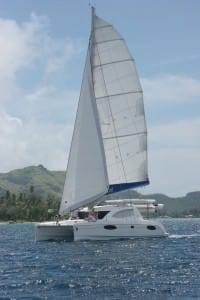
What is a Catamaran?
A traditional sailboat is a monohull–in other words, it has only one hull centered around a heavy keel. A catamaran is balanced on two hulls, with the sails in the middle. It’s as simple as that. Depending on the size of the boat, the space separating the two hulls might be filled by a cockpit, a main cabin, and usually some netting (which can be a great place for relaxing in the sun). Why are Catamarans Popular?

In response to their rise in popularity, ASA developed 114: Cruising Catamaran . This course is ideal for people who already have monohull cruising experience and want to translate that over to the catamaran. You’ll learn all the advantages and disadvantages of multihull sailing so that you’ll always be making an informed decision when considering which boat to charter or buy. You’ll also get the practical sailing skills you need to be confident and have a great time on your cat. Contact an ASA school near you to see if they offer ASA 114: Cruising Catamaran.

- Charter Resources
- Your First Charter Sailing Vacation Today bareboat chartering is the culmination of your sailing education. When you walk across the deck and get your sailing diploma you step on to the metaphorical boat of your future and you can sail it anywhere you want!
- Charter Sailboat Resources Whether you have just begun to sail and have recently earned your ASA 101 certification or if you have already mastered ASA 114 and are a veteran of bareboat charters this resource should help you.
- Bareboat Charter in the BVI Getting aboard your bareboat charter is the goal when you get your ASA sailing certifications. Where do you begin? For many, it is a sailing vacation in the British Virgin Islands.
- Choosing a Charter Boat Company It’s time for you to set off on your own and explore endless shorelines and secluded coves. You have mapped out your plan and you have reserved your vacation time now all you need is a boat. How do you choose a charter company to rent a boat for a week?
- Choosing The Right Boat for Your Sailing Charter When you decide to take a sailing vacation aboard a sailing vessel that you will call home for a week or two you’ll be surprised by just how much you think you need.
- Sailing in Europe? Chartering overseas is on the bucket list of many a sailor, but making it happen comes with a stipulation or two. A sizable number of countries require an International Proficiency Certificate that lets them know the charterer is trained, qualified and prepared to take one of their boats out to sea.
Related Posts:

- Learn To Sail
- Mobile Apps
- Online Courses
- Upcoming Courses
- Sailor Resources
- ASA Log Book
- Bite Sized Lessons
- Knots Made Easy
- Catamaran Challenge
- Sailing Vacations
- Sailing Cruises
- International Proficiency Certificate
- Find A Charter
- All Articles
- Sailing Tips
- Sailing Terms
- Destinations
- Environmental
- Initiatives
- Instructor Resources
- Become An Instructor
- Become An ASA School
- Member / Instructor Login
- Affiliate Login

How To Sail A Catamaran? (A Detailed Step-By-Step Guide)

Are you an adventurous soul looking for an exciting way to explore the open waters? If so, then sailing a catamaran may just be the perfect activity for you! Catamarans are becoming increasingly popular for sailing due to their stability and speed, and when sailed correctly, can be a powerfully enjoyable experience.
This guide will walk you through the basics of sailing a catamaran, from understanding the basics of sailing to handling the boat in different conditions and beyond.
Here, we will cover the differences between a monohull and a catamaran, balancing the boat, basic sailing techniques, safety precautions, and tips for improving your catamaran sailing skills.
So grab your gear and lets get sailing!
Table of Contents
Short Answer
Sailing a catamaran is relatively straightforward.
To get started, adjust the sails and rudder to the desired angles.
Next, begin to move forward using the power of the wind and the force of the sails.
While underway, make sure to constantly adjust the sails and rudder to maintain the desired course.
Finally, when ready to stop, lower the sails and use the rudder to bring the catamaran to a stop.
Understanding the Basics of Sailing
Learning how to sail a catamaran can be an exciting and rewarding experience, but before you can take to the open waters you need to understand the basics of sailing.
It is important to familiarize yourself with the fundamentals of sailing, such as understanding wind direction and how to use sails.
Knowing the basics is essential for anyone wanting to sail a catamaran, as it will allow you to make informed decisions when sailing and will help keep you safe on the water.
Understanding wind direction is a key part of sailing, as it will help you determine the best way to sail and how to use the sails to propel the boat in the desired direction.
This can be done by looking at the flags or flags on other boats in the area, as well as by analyzing the behavior of the waves and the wind.
Additionally, you should also learn the different points of sail, which are the directions a boat can sail relative to the wind.
In addition to understanding wind direction, it is also important to understand how to use the sails of a catamaran.
The sails of a catamaran are made up of two mainsails, which are the two large sails on either side of the boat, as well as a jib, which is a smaller sail located at the front.
Knowing how to properly set the sails will allow you to make the most of the wind and propel the boat in the desired direction.
Additionally, you should also learn how to trim the sails, as this will help you to optimize the boats performance in different wind conditions.
Understanding the basics of sailing and how to use the sails of a catamaran is essential for anyone wanting to learn how to sail a catamaran.
With the right knowledge and practice, sailing a catamaran can be an incredibly rewarding experience.
The Differences Between a Monohull and a Catamaran

When it comes to sailing a catamaran, it is important to understand the differences between a monohull and a catamaran.
A monohull is a single-hulled boat with a keel that runs along the bottom of the boat.
This helps keep the boat stable and upright in the water.
A catamaran, on the other hand, has two hulls which are usually connected by a bridgedeck.
This helps to create a more stable platform in the water and allows for more open space on the boat.
There are some important differences between sailing a monohull and a catamaran.
For example, a monohull requires more power to move through the water and is more limited in terms of maneuverability.
On the other hand, a catamaran is more maneuverable and can be sailed in a variety of conditions.
Additionally, a catamaran is inherently more stable in the water and can handle larger waves.
Another important difference between a monohull and a catamaran is the way they are balanced.
A monohull relies on its keel for stability and must be balanced evenly along the length of the boat.
On the other hand, a catamaran relies on the two hulls to remain balanced and can be sailed with one hull slightly higher than the other.
This allows for greater maneuverability and can help to reduce drag in the water.
Finally, a catamaran is more efficient than a monohull and can be sailed at higher speeds for longer distances.
This makes it ideal for longer trips and open-water sailing.
Balancing the Boat
When it comes to sailing a catamaran, one of the most important steps is learning how to balance the boat.
This is because catamarans have two hulls, which means that they have twice the length and twice the width of a single-hull boat.
This can make it more difficult to keep the boat upright and stable in the water.
When sailing a catamaran, it is important to keep the hulls balanced so that the boat remains stable.
The easiest way to do this is to make sure that the weight is evenly distributed between the two hulls.
This can be done by ensuring that the sail is properly adjusted and that the passengers are sitting evenly between the two hulls.
Additionally, it is important to keep an eye on the wind direction and make sure that the sails are adjusted accordingly.
Furthermore, it is important to be aware of the boats center of gravity.
This is the point at which the boats weight is evenly distributed between the two hulls.
If the boat is not properly balanced, then it can become difficult to control, especially in rough conditions.
It is important to be aware of the boats center of gravity at all times and adjust the weight distribution accordingly.
Finally, it is important to remember that cats are less forgiving than other types of boats.
This means that any errors in balance or sail trim can be exaggerated and lead to a dangerous situation.
Therefore, it is important to practice balancing the boat in calm waters before venturing out in rougher conditions.
By following these steps, sailing a catamaran should be a rewarding and enjoyable experience.
With the right knowledge and practice, anyone can learn how to sail a catamaran safely and confidently.
Handling the Boat in Different Conditions

When sailing a catamaran, it is important to understand how to handle the boat in different conditions, such as in waves and strong winds.
In wave conditions, the key is to keep the boat balanced.
This means keeping the weight evenly distributed between the two hulls and using the sail to keep the boat stable.
To do this, you can adjust the angle of the sail and the trim of the boat to match the waves.
It is also important to keep an eye on the wind direction, as this can affect the boats stability.
In strong winds, it is important to know how to properly balance the boat.
This means keeping the weight evenly distributed between the two hulls and using the sails to keep the boat stable.
You can adjust the trim of the sail and the angle of the sail to match the wind direction.
It is also important to keep an eye on the wind speed, as this can affect how much power you need to use in the sails.
Finally, it is important to know how to handle the boat in rough weather.
This means using the sails to provide stability and keeping the boat balanced in rough conditions.
You should also be prepared to use the outriggers, which are the stabilizers that run along the sides of the boat, to help keep the boat upright in strong winds.
By familiarizing yourself with the basics of sailing and understanding how to handle the boat in different conditions, such as waves and strong winds, you can become a confident and skilled catamaran sailor.
With practice and experience, you can explore the open water with confidence and enjoy the unique experience of sailing a catamaran.
Basic Catamaran Sailing Techniques
Sailing a catamaran can be a great way to explore the open water and experience the thrill of the sea.
Before you set out, however, its important to understand the basics of sailing, such as wind direction and how to use sails.
Once youve got the basics down, you can then start to learn the specifics of how to sail a catamaran.
The most important thing to understand is the difference between a monohull and a catamaran.
Catamarans have two hulls, which make them more stable than monohulls.
This means you will need to learn how to properly balance the boat, as the two hulls can move independently of each other.
You should also be aware of the wind and current when youre sailing, as these can affect the boats stability.
When youre ready to start sailing, youll need to make sure that the sails are set properly and the boat is balanced correctly.
To do this, youll need to be aware of the wind direction and adjust the sails accordingly.
You should also make sure that the sails are trimmed properly, as this will help you to get the most out of the wind.
In order to properly sail a catamaran, youll also need to understand how to handle the boat in different conditions.
This includes handling the boat in waves, strong winds, and other challenging scenarios.
To do this, youll need to be aware of the wind direction, the current, and the waves.
You should also be aware of how the boat responds to different conditions, and be prepared to make adjustments as necessary.
Once youve got the basics of sailing a catamaran down, you can start to explore the open water.
So, dont be afraid to get out on the open water and learn the ins and outs of sailing a catamaran.
With a bit of practice, youll soon be able to enjoy the thrill of the open water.
Safety Precautions for Catamaran Sailing

Before sailing a catamaran, it is important to take safety precautions to ensure your trip is safe and enjoyable.
The first step in doing so is to make sure you have the right safety gear, such as a life jacket, flares, and a first-aid kit.
It is also a good idea to check the weather forecast before departing so you can plan your route accordingly, and to make sure you have the right clothing for the conditions.
Additionally, you should always carry a marine radio on board in case of an emergency.
Lastly, make sure you inform someone of your intended route and estimated time of return, so they can come to your aid in the event of an emergency.
By taking these safety precautions, you can enjoy your catamaran sailing experience to the fullest!
Tips for Improving Your Catamaran Sailing Skills
Improving your catamaran sailing skills is all about getting comfortable with the boat and understanding the different conditions youll be sailing in. Its important to start slowly and build your skill level gradually, as this will help you become a more confident and competent sailor. Here are some tips to get you started:
1. Learn the basics of sailing. Knowing the basics of sailing is essential before you start to learn how to sail a catamaran. Understand the basics of wind direction, how to use sails, and how the wind affects the boat. This will help you better understand the catamaran and how to maneuver it.
2. Familiarize yourself with the catamaran. Spend time familiarizing yourself with the catamaran and its components. Learn the differences between a monohull and a catamaran, such as the two hulls and how to properly balance the boat. You should also be aware of the boats capabilities and limitations.
3. Practice sailing in different conditions. Its important to practice sailing in different conditions, such as in waves and strong winds. This will help you become more comfortable with the boat and give you the experience to handle a variety of conditions.
4. Learn how to use the sails. Understanding how to use the sails will help you become a more efficient sailor and get the most out of your catamaran. Learn how to adjust the sails for different wind directions and how to use them to your advantage.
5. Understand the safety precautions. Before you start sailing, make sure you understand the safety precautions. This includes understanding the weather conditions and the safety equipment you need to have on board.
By following these tips, youll be well on your way to becoming a more confident and competent catamaran sailor.
Learning how to sail a catamaran is a great way to explore the world of sailing and open up a world of adventure on the open water.
Final Thoughts
Whether you’re a seasoned sailor or a novice, knowing how to sail a catamaran can be a great way to get out and explore the open waters.
With the right knowledge and practice, you can become a confident and competent catamaran sailor.
From understanding the basics of sailing, to learning the differences between a monohull and a catamaran, to mastering the techniques of catamaran sailing, this detailed step-by-step guide has all the information you need to become a successful catamaran sailor.
So, what are you waiting for? Get out there and start your catamaran sailing journey today!
James Frami
At the age of 15, he and four other friends from his neighborhood constructed their first boat. He has been sailing for almost 30 years and has a wealth of knowledge that he wants to share with others.
Recent Posts
Does Your Boat License Expire? Here's What You Need to Know
Are you a boat owner looking to stay up-to-date on your license requirements? If so, youve come to the right place! In this article, well cover everything you need to know about boat license...
How to Put Skins on Your Boat in Sea of Thieves? (Complete Guide)
There is a unique sense of pride and accomplishment when you show off a boat you customized to your exact specifications. With Sea of Thieves, you can customize your boat to make it look like your...

FREE CANCELLATION & RESCHEDULING 2024
+385 21 55 33 01 +385 91 3000 009
+385 91 3000 009
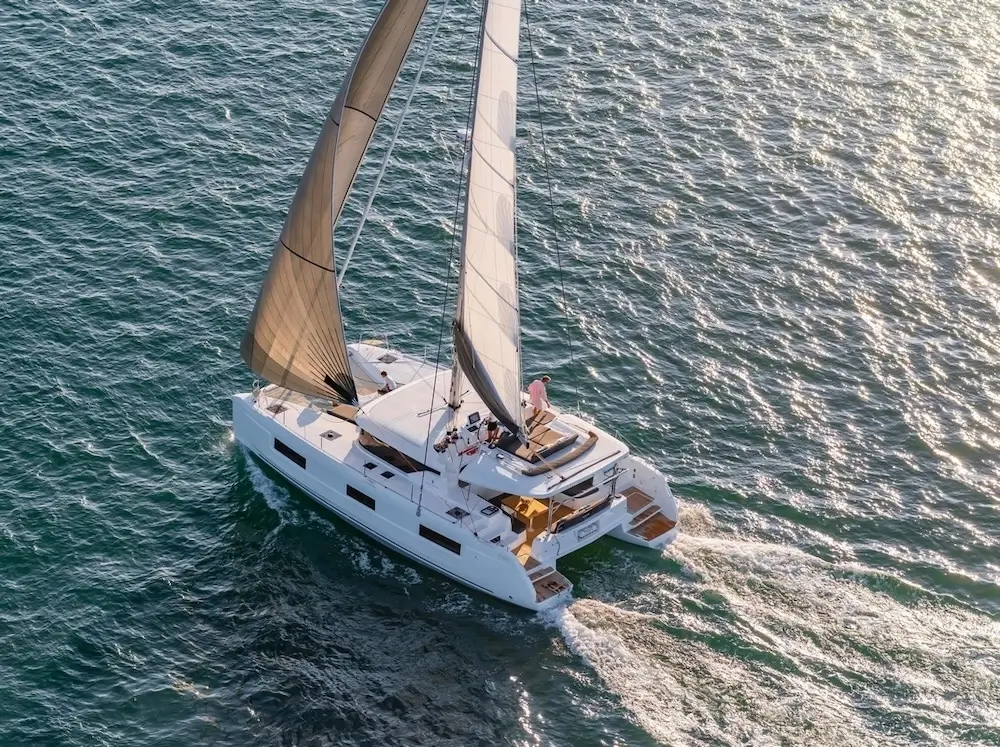
Is it more difficult to sail a catamaran?
The age-old debate in the sailing community often revolves around the complexity and ease of sailing different types of vessels. Among the top contenders for this discussion is the catamaran, a vessel known for its stability and space. But is it truly more challenging to sail than its counterparts? Let’s embark on this exploration.
Understanding the Catamaran
Before delving into the intricacies of sailing, it’s essential to grasp what makes a catamaran unique.
Origin and Evolution
The catamaran’s design finds its roots in the South Pacific, where indigenous people crafted these double-hulled boats to travel between islands. Their evolution in the modern world has seen enhancements in design, primarily focusing on speed, stability, and comfort.
Structural Design
The hallmark of a catamaran is its twin hulls, connected by a rigid platform. This dual-hull structure distributes the vessel’s weight more evenly across the water’s surface, leading to increased stability, especially in turbulent conditions.
Popularity Surge
With their rise in popularity, many sailors, both novices and veterans, are drawn to catamarans. Their appeal often lies in the promise of spacious accommodations and a smoother sailing experience, especially in regions like the Mediterranean. If you’ve ever considered bareboat sailing in Greece , you’d know the allure catamarans hold in such serene waters.
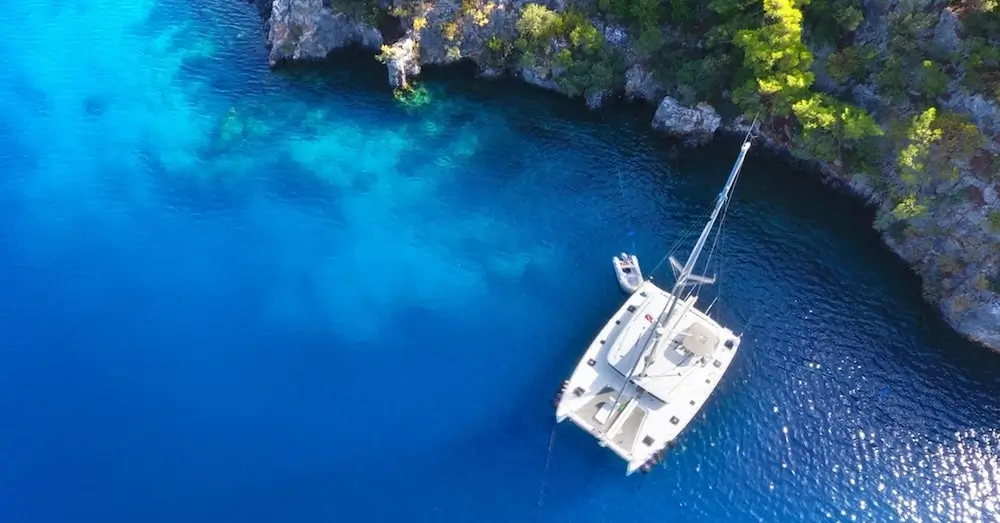
Is It More Difficult To Sail A Catamaran 2
Sailing a Catamaran: Advantages
To determine if sailing a catamaran is indeed more difficult, we need to first understand its benefits.
Stability on Water
The broad stance of the twin hulls provides an unparalleled level of comfort, even in choppy waters. This feature reduces the vessel’s proclivity to tilt or heel, ensuring passengers have a consistent and stable experience.
Expansive Living Quarters
For those who prioritize space, catamarans are the answer. With wide decks and generous interiors, they offer more living and storage areas than monohulls of equivalent length.
Navigating Shallow Regions
Catamarans boast a shallow draft, a trait allowing them to sail into regions that deeper-hulled vessels might find challenging. This advantage means sailors can explore secluded beaches, hidden coves, and other off-the-beaten-path locations.
Monetary Aspects: Catamarans Vs. Yachts
One cannot discuss sailing without addressing the financial aspects. When debating whether catamarans are more economical than yachts , several considerations come into play, including maintenance costs, fuel efficiency, and initial investment.
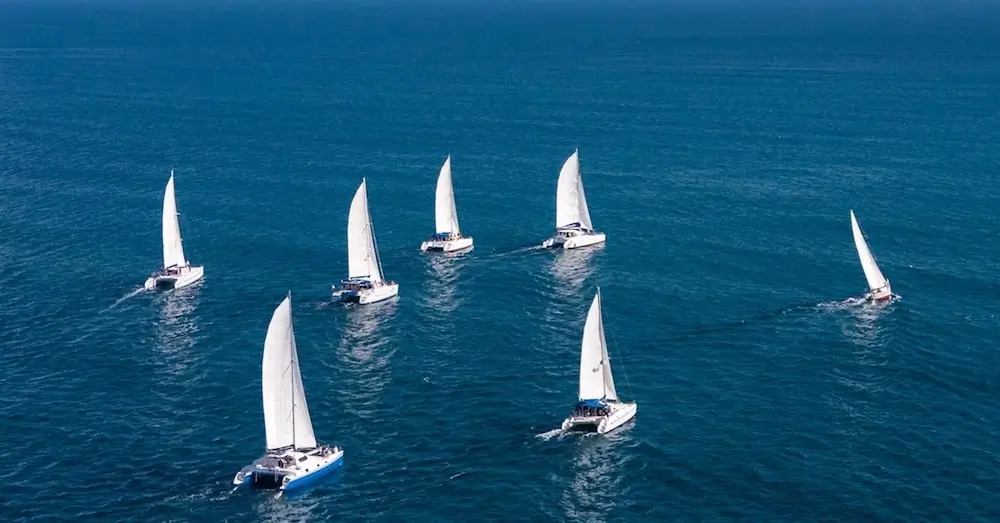
Is It More Difficult To Sail A Catamaran 3
Challenges Associated with Sailing Catamarans
Despite their plethora of advantages, catamarans do present specific challenges that sailors must navigate. Understanding these complexities is key to making an informed decision about whether catamaran sailing is right for you.
Maneuverability in Tight Spaces
While catamarans boast an impressive stability in open waters, their wide structure can pose difficulties in tight harbors or marinas. This spatial challenge demands greater skill and precision from the sailor, especially when docking or mooring.
Windage Concerns
The expansive surface area of a catamaran, including its hulls and superstructure, can be impacted significantly by strong winds. This large windage can make certain maneuvers more challenging, especially in stormy conditions.
Tacking Techniques
Tacking, or changing the boat’s direction relative to the wind, can be slightly more complex on a catamaran than on a monohull. Given the boat’s design, sailors often need to maintain momentum and use precise techniques to ensure smooth tacks.
Speed Limitations
While catamarans can achieve impressive speeds downwind, they may not always match the upwind speeds of performance monohulls. It’s essential for sailors to understand these limitations and adjust their sailing strategies accordingly.
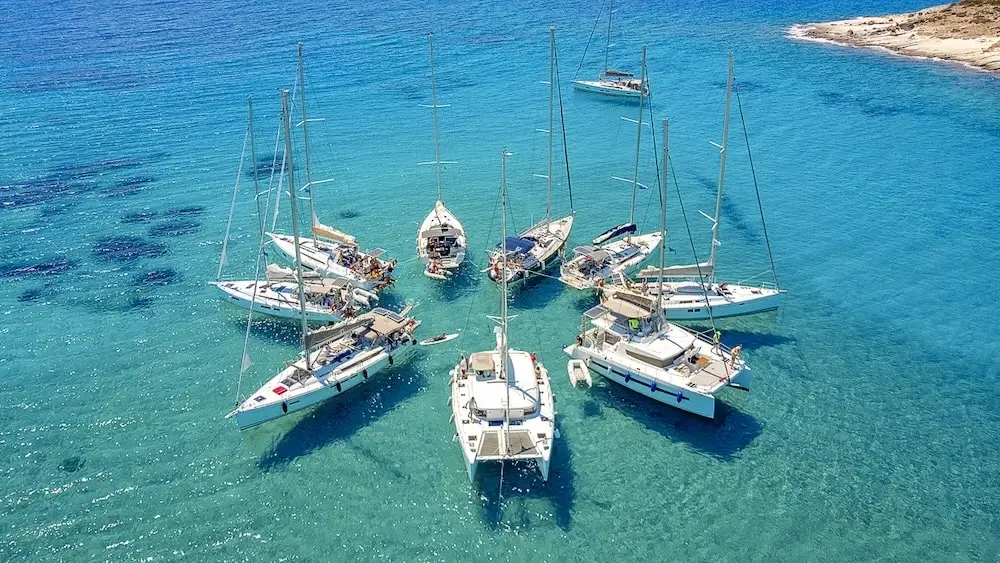
Is It More Difficult To Sail A Catamaran 4
Preparing to Sail a Catamaran
For those new to catamarans, preparation is key. Here’s how you can brace yourself for a seamless experience.
Training and Courses
Consider undertaking specialized training courses that focus on catamaran-specific techniques. These courses often delve into the nuances of handling twin-hulled vessels and can significantly boost confidence.
Understand Your Vessel
Each catamaran is unique. Spend time getting to know your vessel, its systems, and its quirks. Familiarity can greatly assist in handling challenging situations.
Choose the Right Charter
If you’re looking to charter a catamaran, be discerning in your choice. Ensure the charter aligns with your skill level and the kind of experience you seek. For instance, Greece offers some splendid options, and finding the best place to yacht rental Greece can significantly influence your sailing experience.
Embracing the Catamaran Experience
While challenges exist, many seasoned sailors and newcomers alike have embraced the allure of catamarans. Their benefits often outweigh the learning curve, making them a sought-after choice for many maritime adventures.

Is It More Difficult To Sail A Catamaran 5
Safety and Stability
Thanks to their twin-hulled design, catamarans are known for their stability. The risk of capsizing is significantly reduced, especially when compared to traditional monohull vessels. This feature not only ensures safety but also provides peace of mind to those on board, especially during longer voyages.
Spaciousness and Comfort
One cannot discuss catamarans without highlighting the ample space they offer. With large deck areas, spacious cabins, and expansive lounging areas, catamarans are ideal for those who value comfort during their sea journeys. Whether you’re on a family vacation, a romantic getaway, or an expedition with friends, the catamaran ensures everyone has their own personal space.
A Unique Sailing Sensation
Sailing a catamaran offers a distinct sensation that’s different from traditional sailing vessels. The absence of heeling, combined with the vessel’s gentle movement, offers a smooth sailing experience. For those who might be prone to seasickness on monohulls, catamarans can be a game-changer.
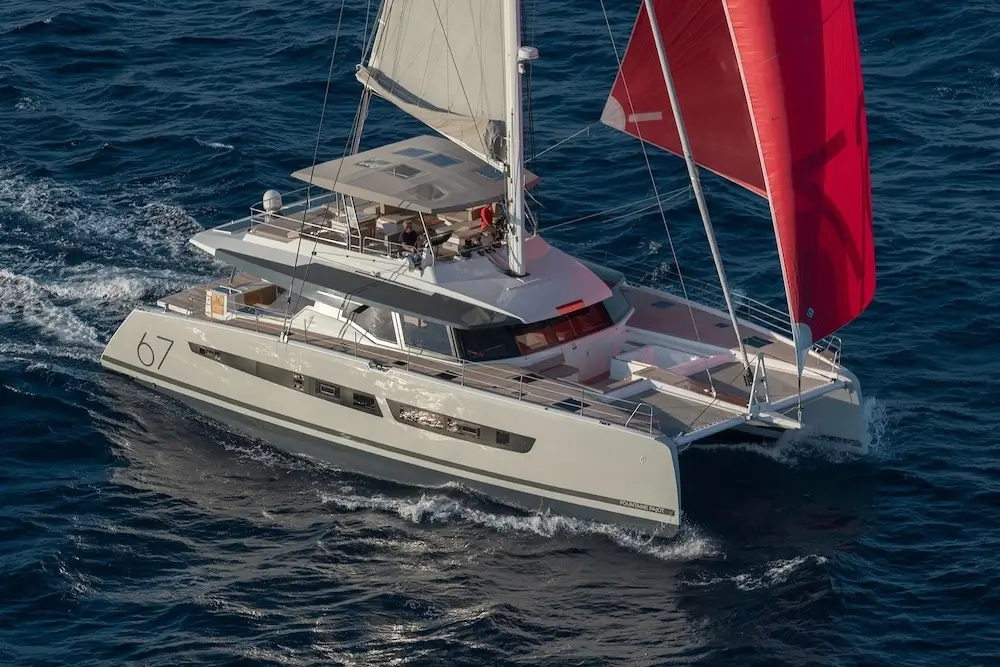
Is It More Difficult To Sail A Catamaran 6
Choosing the Right Catamaran
If you’re convinced about the merits of catamaran sailing and are looking to charter one for your next adventure, it’s essential to make the right choice. Platforms like Catamaran Charter Greece provide a diverse range of options tailored to different needs and experience levels.
Conclusion: The Catamaran Phenomenon
Sailing, at its core, is about the harmony of man, machine, and nature. Catamarans, with their unique design and features, have carved a niche for themselves in the world of sailing. While they do present certain challenges, with the right training and mindset, these can be easily navigated. Whether you’re a seasoned sailor looking for a change or a newbie drawn to the allure of the twin hulls, catamarans promise an unforgettable sailing experience.
For those looking to embark on a sailing adventure, remember to weigh the pros and cons, and perhaps even consider other options like yacht rental Greece to see which aligns best with your maritime dreams.
Related Posts

Sailing differences between South and North Ionian islands

10 Things to do in Milos that you didn’t expect

10 Best things to do and see in Kefalonia

The Ultimate Guide to Choosing Between a Sailboat or Catamaran for Your Sailing Adventures
C hoosing between a sailboat and a catamaran for your sailing adventures is a significant decision that depends on various factors, including your sailing preferences, experience level, budget, and intended use. Here's an ultimate guide to help you make an informed decision:
1. Sailing Experience:
- Sailboats: Typically require more skill and experience to handle, especially in adverse weather conditions. Ideal for sailors who enjoy the traditional feel of sailing and are willing to invest time in learning and mastering the art.
- Catamarans: Easier to handle, making them suitable for beginners. The dual-hull design provides stability, reducing the learning curve for those new to sailing.
2. Space and Comfort:
- Sailboats: Generally have a narrower beam and less living space. However, some sailboats may offer comfortable cabins and amenities.
- Catamarans: Wider beam creates more living space. Catamarans often have multiple cabins, spacious saloons, and expansive deck areas, providing a more comfortable living experience.
3. Stability:
- Sailboats: Monohulls can heel (lean) while sailing, which some sailors enjoy for the thrill but can be discomforting for others.
- Catamarans: Greater stability due to the dual hulls, providing a more level sailing experience. Reduced heeling makes catamarans suitable for those prone to seasickness.
4. Performance:
- Sailboats: Known for their upwind performance and ability to sail close to the wind. Some sailors appreciate the challenge of optimizing sail trim for efficiency.
- Catamarans: Faster on a reach and downwind due to their wide beam. However, they may not point as high into the wind as monohulls.
- Sailboats: Typically have a deeper draft, limiting access to shallow anchorages and requiring deeper marina berths.
- Catamarans: Shallow draft allows access to shallower waters and secluded anchorages, providing more flexibility in cruising destinations.
- Sailboats: Generally more affordable upfront, with a wide range of options available to fit different budgets.
- Catamarans: Often more expensive upfront due to their size and design. However, maintenance costs may be comparable or even lower in some cases.
7. Mooring and Docking:
- Sailboats: Easier to find slips and moorings in marinas designed for monohulls.
- Catamarans: Require wider slips and may have limited availability in certain marinas, especially in crowded anchorages.
8. Intended Use:
- Sailboats: Ideal for traditional sailors who enjoy the art of sailing, racing enthusiasts, or those on a tighter budget.
- Catamarans: Suited for those prioritizing comfort, stability, and spacious living areas, especially for long-term cruising and chartering.
9. Resale Value:
- Sailboats: Generally have a more established resale market, with a wider range of buyers.
- Catamarans: Growing in popularity, and well-maintained catamarans often retain their value.
10. Personal Preference:
- Consider your personal preferences, the type of sailing you plan to do, and the kind of lifestyle you want aboard your vessel.
In conclusion, both sailboats and catamarans have their advantages and disadvantages. Your decision should be based on your individual preferences, experience level, budget, and intended use. If possible, charter both types of vessels to experience firsthand how they handle and to help make a more informed decision based on your own preferences and needs.
The post The Ultimate Guide to Choosing Between a Sailboat or Catamaran for Your Sailing Adventures appeared first on Things That Make People Go Aww .


Can You Sail a Catamaran By Yourself?

Last Updated by
Daniel Wade
August 30, 2022
Catamarans are known for their stability and comfort, but are they too complex to sail single handed?
You can sail most small and medium-sized cruising catamarans by yourself. Thanks to technological advances such as electric winches and powered sail control, it's easier than ever to sail a catamaran single handed.
In this article, we'll go over the nuances of sailing a catamaran by yourself. We'll cover the different sizes of catamarans and which are best to sail solo. We'll also go over a few tips for successfully piloting a catamaran without a crew.
We sourced the information in this article from the online sailing community and sailors who have single handed a catamaran.
Table of contents
Are Catamarans Easy to Sail?
Catamarans are not necessarily easier to sail on their own, but they do have some characteristics that make them safer and more pleasant. Catamarans have an enormous amount of inherent stability.
They divide the force of the wind between two equally sized hulls, which almost entirely eliminates heeling and the dangers associated with it.
Catamarans are also much faster than equivalently-sized monohulls. This is because they don't suffer from hull speed limitations, which are caused by interfering bow and stern waves on monohull sailboats.
This is actually detrimental for singlehanded sailing, as additional speed reduces the time you have to react to danger.
The primary benefit of additional stability is reduced risk of falling overboard or getting injured during tight maneuvers. Additionally, catamarans are extremely difficult to capsize, which increases the amount of time you have to react to a sudden gust or changing sea conditions.
As you can see, single-handing a catamaran is really more of a mixed bag than a cut-and-dry alternative. There are benefits and drawbacks, though it is possible to sail a catamaran by yourself (provided you have the necessary experience to handle a different kind of boat).
What Size Catamaran is Best for Singlehanded Sailing?
Catamarans come in lots of different sizes, though they're not as varied as monohulls. There are two primary types of catamarans: open catamarans and cruising catamarans.
Open catamarans are small and useless for long-distance travel. These boats are primarily for recreation and racing, and they have a limited market. Almost all open catamarans are designed for singlehanded sailing, though some of them can accommodate a crew of two or more people.
Cruising catamarans are completely different beasts. These vessels start at around 30 to 35 feet long and top out around 50 feet.
Anything longer than 60 feet is likely a superyacht, and only a handful of these types of catamarans exist. No catamaran in the superyacht category can be sailed single handed without the help of complex electromechanical and automated systems.
The ideal size for a cruising catamaran is around 35 feet to 45 feet if you intend to sail it yourself. These sizes are manageable due to the limited force required to manipulate halyards and reef the sail.
Also, visibility on a smaller cruising catamaran is usually adequate to maneuver without additional spotters. These vessels make it easier to get to the sail and winches in a short time, as you don't have to run 20 feet between the cockpit and the mast.
Electronic and Mechanical Controls
Some of the larger and more luxurious catamarans come equipped with advanced automatic controls. These systems allow you to raise, lower, and reef the sail from the cockpit, theoretically enabling a single person to perform these tasks while continuing to steer.
Automated winches are increasingly common on larger catamarans, as they reduce the energy required to do relatively simple tasks and allow the crew to focus on navigation.
These systems have proven to be quite reliable even in the harshest conditions, though they should never be trusted completely in place of a competent crew. As a result, the maximum size of catamaran that can be safely singlehanded is still limited.
That's said, having these systems certainly makes it a lot easier and safer to sail a catamaran alone. Smaller catamarans are also being equipped with automatic controls, and autopilot has been available for quite some time.
Do People Buy Catamarans for Singlehanded Sailing?
Generally speaking, people don't purchase catamarans solely for the purpose of singlehanded sailing. Catamarans are more popular for families and groups, as they have more comfortable accommodations in their large double hulls. This is why you don't happen to see catamarans manned by a single person.
Smaller specialty catamarans have been produced for ages. These vessels were often crewed by a single person, but they were made specifically for breaking a record for extreme exploration. Catamarans like these live in record books but aren't manufactured or sold to the wider public.
Challenges of Sailing a Catamaran By Yourself
Catamaran sailing poses a number of challenges, particularly when it comes to the shape of the boat. Catamarans have an extremely wide stance, which makes them difficult to maneuver in tight spaces. Some catamarans have thrusters that can somewhat alleviate these issues.
Additionally, catamarans are more difficult to get around than monohulls. Tending to the boom isn't as simple as reaching overhead in many cases, especially with closed-cockpit models.
But overall, catamarans have a lot more benefits than drawbacks. Singlehanded sailing can be challenging, as you can't dive into the cockpit from the deck like you can on a monohull in the event that you need to rapidly steer the boat.
Additionally, catamarans have a lot of interior space. While this isn't necessarily a problem, it begs the question—what's the point of having such a big and expensive boat if 90% of the interior space goes unused?
Single Handed Catamaran Sailing Tips
Sailing a catamaran single handed is completely possible, although it does require a different set of skills than sailing a monohull. Here are a few tips to help make single handed catamaran sailing safer and easier.
1. Sleep in the Pilothouse
Most cruising catamarans have a spacious covered cockpit, also known as the pilot House. The pilothouse usually contains the galley and a large sitting area for eating or plotting charts.
In the vast majority of cases, the sitting area in the pilothouse can be easily converted into a large bed. It is much safer to sleep in the pilothouse than in the lower hulls while singlehanded sailing.
This is because, when you're sleeping, nobody else will be on watch. If a situation arises and you need to take control of the boat, you have a much better chance of getting to the helm in time if you're sleeping in the cockpit.
2. Install Warning Radar
This goes for all single handed sailors. Installing a warning radar system can make your journey significantly safer. These systems alert you to the presence of nearby ships, such as cargo ships, and give you identifying information such as vessel size and speed.
Marine radar systems can alert you with an audio alarm if you pass within a certain distance of another vessel. This can be useful if you intend to communicate with the vessel, and it can also wake you up if you need to take control of the boat.
Remember, commercial traffic and warships always have the right of way. This is because the stopping distance and turning radius of a large ship are measured in miles, not feet, and you can maneuver much quicker than they can. Again, they will not get out of your way—and radar can tell you when you need to move.
3. Install Automatic Winches
Automatic winches can make singlehanded sailing an absolute breeze. These electric devices allow you to control lines and sheets from the cockpit, and you never have to go out on deck except to raise and lower the sail. Some automatic systems can even reef the sails.
Additionally, automatic winches can save energy, as you don't have to exhaust yourself reeling in and taking out the line. Automatic winches are particularly useful when tacking, as the headsail can be adjusted to either side without going up on deck.
Advanced automatic controls can be linked to your autopilot system. The system can steer instead of your boat and use the weather data from instruments to adjust the sails for maximum speed and efficiency.
4. Buy a Smaller Catamaran
Smaller boats are usually easier to handle—it's a simple fact about sailing. If you plan on single-handing a catamaran, why purchase a 50-footer when a 40-footer would be more than adequate?
There's a point where the seaworthiness tends to flatten out, and a 40 to 45-foot catamaran can handle just about any reasonable sailing conditions without much trouble. You'll save money on slip and lock transit fees, and it'll be easier for you to manage by yourself. Plus, there's still plenty of room for guests to come aboard.
Related Articles
I've personally had thousands of questions about sailing and sailboats over the years. As I learn and experience sailing, and the community, I share the answers that work and make sense to me, here on Life of Sailing.
by this author
Most Recent

What Does "Sailing By The Lee" Mean?
October 3, 2023

The Best Sailing Schools And Programs: Reviews & Ratings
September 26, 2023
Important Legal Info
Lifeofsailing.com is a participant in the Amazon Services LLC Associates Program, an affiliate advertising program designed to provide a means for sites to earn advertising fees by advertising and linking to Amazon. This site also participates in other affiliate programs and is compensated for referring traffic and business to these companies.
Similar Posts

How To Choose The Right Sailing Instructor
August 16, 2023

Cost To Sail Around The World
May 16, 2023

Why Do Catamarans Have Trampolines?
April 17, 2023
Popular Posts

Best Liveaboard Catamaran Sailboats
December 28, 2023

Can a Novice Sail Around the World?
Elizabeth O'Malley
June 15, 2022

4 Best Electric Outboard Motors

How Long Did It Take The Vikings To Sail To England?

10 Best Sailboat Brands (And Why)
December 20, 2023

7 Best Places To Liveaboard A Sailboat
Get the best sailing content.
Top Rated Posts
Lifeofsailing.com is a participant in the Amazon Services LLC Associates Program, an affiliate advertising program designed to provide a means for sites to earn advertising fees by advertising and linking to Amazon. This site also participates in other affiliate programs and is compensated for referring traffic and business to these companies. (866) 342-SAIL
© 2024 Life of Sailing Email: [email protected] Address: 11816 Inwood Rd #3024 Dallas, TX 75244 Disclaimer Privacy Policy
Electric boats
Electric yachts.
- Solar Electric Boats
- Sunreef Yachts
Sunreef Yachts unveils new luxe solar electric Explorer catamaran with over 1,000 kWh in batteries
Sustainable boatbuilder Sunreef Yachts is adding a sleeker, lighter solar electric catamaran to its portfolio. The new Explorer Eco 40m is the company’s smallest electric yacht to date, but debuts with some of the most advanced technology, including Sunreef’s proprietary “solar skin”
Sunreef Yachts was established in 2002 in Gdansk, Poland where its shipyard and office still operate alongside a newer footprint established at port in the United Arab Emirates. From its very first year, Sunreef has been pushing the boundaries of sustainable marine travel, launching the world’s first 74-foot luxury oceangoing catamaran with a flybridge.
Today, hundreds of Sunreef Yachts are sailing waters across the globe, showcasing the company’s lineup of sustainable luxury catamarans, all-electric propulsion, and advanced solar panels. That current portfolio consists of eco-friendly sailboats and massive solar electric catamarans ranging from 60 to 100 meters in length.
Today, Sunreef shared it has gone smaller, introducing a new 40m electric yacht called the Eco Explorer.
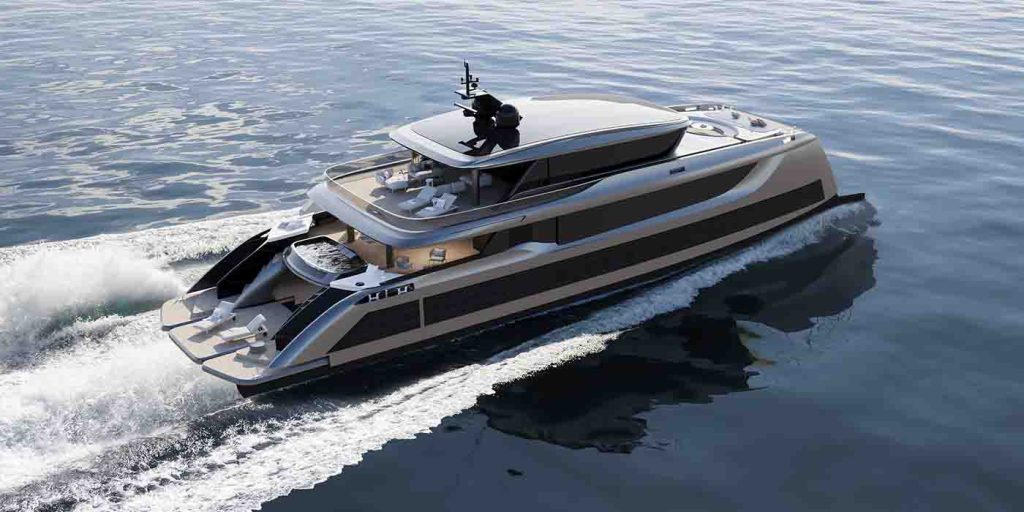
Sunreef Yacht’s latest electric catamaran is another beauty
Top comment by arno hayes.
I can't wait for ships to start using latent heat batteries with TPV. It might change the whole conversation about electric shipping. To a paradigm where nothing but electric shipping makes sense. Carbon variants can have volumetric energy density upwards of 1.5MWh/m3 (641kg). Though not all of that useable at maximum power output, I'm guessing. Let's call it 1MWh of useable energy. Pure guesstimate. You'd need 4000kg of 250Wh/kg LiIon batteries do the same.
I think a vessel as big as this would be capable of employing a storage system like that. And I believe that they will be suitable for trains and even larger airplanes. Maybe even trucks.
The company’s new Eco version of the 40m Explorer offers customers a sleeker and more sustainable design in a lighter marine footprint, all without sacrificing the luxury and comfort Sunreef is known for.
Sunreef shared that it favors catamarans over traditional yacht hull designs because require less energy to propel at sea – an important factor in marine electrification. The new Eco Explorer 40m features an ultralight composite build and a state-of-the-art electric powertrain consisting of two 540kW motors and two 550 kWh battery packs – giving the electric yacht the ability to cross oceans.
To support the all-electric powertrain, the Eco Explorer 40m is also covered in Sunreef’s proprietary solar skin, which utilizes every available inch of the hull and structure’s external surface to generate free, clean energy – more than enough to power the electric yacht’s onboard systems, HVAC, AV equipment and even its jacuzzi. Per Sunreef Yachts founder and CEO Francis Lapp:
Sunreef has been at the cutting edge of sustainable yachting since its launch. We are the only superyacht builder to have successfully developed the idea of embedding solar cells into large-scale fibreglass structures. But we’re not content to let technology alone do the work. Many elements of our wonderful, custom interiors can also be sourced from recycled and renewable materials. From hemp composite to recycled fabrics -it’s all up to the owner.
Sunreef says its new Eco Explorer 40m can accommodate 10 guests aboard, who can be taken care of by a crew of seven. Its motors deliver a cruising speed of 10 knots and a top speed of 14 knots. Build times are currently three years, and the electric yachts will be built at one of Sunreef’s ports in Poland or the UAE.
FTC: We use income earning auto affiliate links. More.


Scooter Doll is a writer, designer and tech enthusiast born in Chicago and based on the West Coast. When he’s not offering the latest tech how tos or insights, he’s probably watching Chicago sports. Please send any tips or suggestions, or dog photos to him at [email protected]

IMAGES
VIDEO
COMMENTS
Catamarans are not hard to sail compared to monohulls due to their superior stability, ease of handling, maneuverability, and visibility from the helm. They can outrun bad weather and deliver a first-rate sailing performance. The most notable downside is catamarans have difficulty sailing close to the wind.
A catamaran offers flat, even decks, wide, safe passages, and no climbing when having to move from bow to stern. Tips for Sailing a Catamaran. With its large area exposed to wind and its low draft, a sailing catamaran can drift off easily so anchoring should be performed as swiftly as possible, especially if the wind blows from the side.
Understanding the Basics of a Catamaran. Understanding the basics of a catamaran is essential for safe and enjoyable sailing. A catamaran is a boat with two parallel hulls connected by a deck. It has advantages over monohull boats. Catamarans are stable due to their wide beam, reducing the risk of capsizing.They can access shallow waters because of their shallow drafts.
Here are some key points to consider about sails and rigging: 1. Sail design: The design of the sails, including their size, shape, and material, plays a significant role in the catamaran's performance. High-performance racing catamarans often have larger, more efficient sails that generate greater speed. 2.
Understanding the Basics of a Catamaran. A catamaran is a boat with two parallel hulls connected by a bridge. Understanding the basics of a catamaran is important to fully enjoy the unique sailing experience it offers. These hulls provide stability and reduce drag, enabling higher speeds. Catamarans are used for sailing, cruising, and racing.. The design allows for a spacious interior layout ...
The reason why catamarans are so popular with sailors, especially in exotic countries, is the very shallow draft — 0.9 to 1.5 metres, depending on the length of the vessel, which means skippers don't have to concern themselves so much about hitting the seabed.While caution and monitoring charts are still necessary, it provides greater freedom in choosing anchorage spots, allowing you to sail ...
Even though the exercise is a little difficult at first, you'll pick it up quickly. Things You Need to Know When Learning to Sail a Catamaran. Catamaran sailing can be learned in any way that works best for you. While some people prefer to learn by reading, others prefer to watch videos. The most important thing is to get on the water and ...
If the sea state makes this difficult, run the leeward engine to make better progress to windward. ... Many of today's performance catamarans can sail at up to 14 knots to windward in ideal conditions. In gale conditions, the ride should be comfortable and safe in the 7-9 knot speed range. Slowing down is easier on the boat, and is certainly ...
10 Catamaran Sailing Tips. Here are some tips on how to sail your catamaran: 1. Always keep the boat sailing downwind. Sailing downwind prevents pounding and slapping sounds that slow down the boat. When the low bridge deck slaps on the undercarriage of the boat, it causes annoying sounds. Making sure that you are sailing downwind as much as ...
A catamaran is a sailboat with two hulls. These two hulls are connected by a bridge deck. Many people will be familiar with Hobie cats, small catamarans that are popular for sailing on lakes and in calmer waters. Cruising catamarans are based on this same principle but have large hulls that can fit many cabins inside, and house large structures ...
Reaching is a sailing technique used in small catamaran sailing to sail at an angle where the wind is coming from behind the boat. It allows the boat to sail faster and more efficiently. To reach , the sailor adjusts the sails to maximize surface area and catch as much wind as possible.
As noted above, catamarans don't really heel over. This makes the entire sailing experience different; the motion of the boat is different, you have to trim the sails differently, and pay attention to other factors that you might not be used to. In light wind and upwind sailing conditions, it can be harder to make headway.
This can make it more difficult to keep the boat upright and stable in the water. When sailing a catamaran, it is important to keep the hulls balanced so that the boat remains stable. ... Improving your catamaran sailing skills is all about getting comfortable with the boat and understanding the different conditions youll be sailing in. Its ...
A cruising catamaran is a boat that operates on the same premise as a sailing catamaran but has bigger hulls with cabins and facilities. A closed building on the bridge, between enormous hulls, serves as a galley, salon, and living quarters. Catamarans are significantly larger and more stable than sailing boats.
To determine if sailing a catamaran is indeed more difficult, we need to first understand its benefits. Stability on Water. The broad stance of the twin hulls provides an unparalleled level of comfort, even in choppy waters. This feature reduces the vessel's proclivity to tilt or heel, ensuring passengers have a consistent and stable ...
Stability: Sailboats: Monohulls can heel (lean) while sailing, which some sailors enjoy for the thrill but can be discomforting for others. Catamarans: Greater stability due to the dual hulls ...
Sailing Catamaran For Beginners ⛵ Learn How to Sail a Catamaran | In today's sailing vlog, we teach you everything we've learned on how to sail a catamaran w...
Catamaran sailing poses a number of challenges, particularly when it comes to the shape of the boat. Catamarans have an extremely wide stance, which makes them difficult to maneuver in tight spaces. Some catamarans have thrusters that can somewhat alleviate these issues.
Is sailing Catamarans more difficult? Catamarans don't heel over. This feature makes sailing with a catamaran a bit different from sailing a classic monohull...
How to sail a catamaran. Sailing on Lagoon 46. SUBSCRIBE to my channel: https://bit.ly/3wLa6vphttp://www.alivesailing.com/https://www.instagram.com/skipper_i...
Sunreef Yacht's latest electric catamaran is another beauty. The company's new Eco version of the 40m Explorer offers customers a sleeker and more sustainable design in a lighter marine ...